Veda Studies and Knowledge
(NameENG)
Notes
READ MORE
Notes
READ MORE
English pronunciation : véda / Vētā / Vētam / Vēdham āyvukaḷ / ñāṉam Vaḷarcci Peṟa / Rikvēdaṁ / Rik vētam / Yajūr vētam / Sāma vētam / Atarvaṉa vētam /
Sanskrit संस्कृतम् : वेद /
Tamil தமிழ் : வேதா / வேதம் ஆய்வுகள் / ஞானம் வளர்ச்சி பெற / ரிக் வேதம் / யஜூர் வேதம் / சாம வேதம் / அதர்வன வேதம்
Bahasa Melayu : Rigvéda / Yajurveda / Sāmavéda / Atharvavéda /
Malayalam : not_available /
Telugu : రుగ్వేదం ( Rugvēdaṁ ) / యజుర్వేదం ( Yajurvēdaṁ) / సామవేదం ( Sāmavēdaṁ ) / అధర్వ వేదం ( Adharva vēdaṁ ) /
Français : not_available
Introduction
The Védas ( Sanskrit : वेद véda, "knowledge" ) are a large body of texts originating in ancient India. Composed in Védic Sanskrit, the texts constitute the oldest layer of Sanskrit literature and the oldest scriptures of Hinduism.
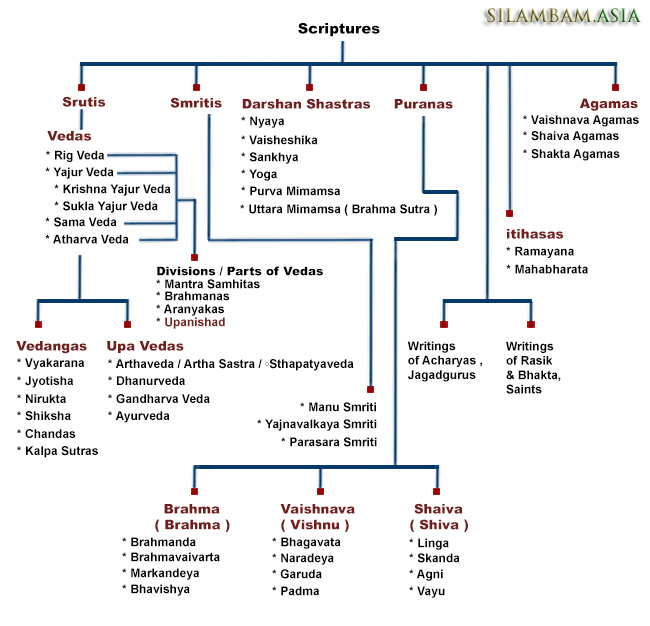
The class of "Védic texts" is aggregated around the 4 canonical Saṃhitās or Védas proper ( turĩya ), of which 3 ( traya ) are related to the performance of yajna ( sacrifice ) in historical ( Iron Age ) Védic religion :
The Rigvéda manuscripts have been selected for inscription in UNESCO's "Memory of the World" Register 2007.
According to Hindu tradition, the Védas are apauruṣeya "not of human agency", are supposed to have been directly revealed, and thus are called Śruti ( "what is heard" ). The 4 Saṃhitās are metrical ( with the exception of prose commentary interspersed in the Black Yajurveda ). The term Saṃhitā literally means "composition, compilation". The individual verses contained in these compilations are known as mantras. Some selected Védic mantras are still recited at prayers, religious functions and other auspicious occasions in contemporary Hinduism.
The various Indian philosophies and sects have taken differing positions on the Védas. Schools of Indian philosophy which cite the Védas as their scriptural authority are classified as "orthodox" ( Āstika ). Other traditions, notably Buddhism and Jainism, which did not regard the Védas as authorities are referred to by traditional Hindu texts as "heterodox" or "non-orthodox" ( Nāstika ) schools. In addition to Buddhism and Jainism, Sikhism and Brāhmoism, many non-Brāhmiṇ Hindus in South India do not accept the authority of the Védas. Certain South Indian Brāhmiṇ communities such as Iyengars consider the Tamil Divya Prabandham or writing of the Alvar saints as equivalent to the Védas. In most Iyengar temples in South India the Divya Prabandham is recited daily along with Védic Hymns.
ETYMOLOGY AND USAGE
The Sanskrit word véda "knowledge, wisdom" is derived from the root vid- "to know". This is reconstructed as being derived from the Proto-Indo-European root *u̯eid-, meaning "see" or "know". As a noun, the word appears only in a single instance in the Rigvéda, in RV 8.19.5, translated by Griffith as "ritual lore" :
yáḥ samídhā yá âhutī / yó védena dadâŚa márto agnáye / yó námasā svadhvaráḥ
"The mortal who hath ministered to Agni with oblation, fuel, ritual lore, and reverence, skilled in sacrifice."
The noun is from Proto-Indo-European *u̯eidos, cognate to Greek (ϝ)εἶδος "aspect", "form" . Not to be confused is the homonymous 1st and 3rd person singular perfect tense véda, cognate to Greek (ϝ)οἶδα (w)oida "I know". Root cognates are Greek ἰδέα, English wit, etc., Latin video "I see", etc.
In English, the term véda is often used loosely to refer to the Saṃhitās ( collection of mantras, or chants ) of the four canonical Védas ( Rigvéda, Yajurveda, Sāmavéda and Atharvavéda ).
The Sanskrit term véda as a common noun means "knowledge", but can also be used to refer to fields of study unrelated to liturgy or ritual, e.g. in agada-véda "medical science", sasya-véda "science of agriculture" or sarpa-véda "science of snakes" ( already found in the early Upanishad or Upaniṣads ); durvéda means "with evil knowledge, ignorant".
CHRONOLOGY
The Védas are among the oldest sacred texts. The Saṃhitās date to roughly 1500–1000 BCE, and the "circum-Védic" texts, as well as the redaction of the Saṃhitās, date to c. 1000-500 BCE, resulting in a Védic period, spanning the mid 2nd to mid 1st millennium BCE, or the Late Bronze Age and the Iron Age. The Védic period reaches its peak only after the composition of the mantra texts, with the establishment of the various shakhas all over Northern India which annotated the mantra Saṃhitās with Brāhmaṃā discussions of their meaning, and reaches its end in the age of Buddha and Panini and the rise of the Mahājanapadas ( archaeologically, Northern Black Polished Ware ). Michael Witzel gives a time span of c. 1500 BCE to c. 500-400 BCE. Witzel makes special reference to the Near Eastern Mitanni material of the 14th c. BCE the only epigraphic record of Indo-Aryan contemporary to the Rigvédic period. He gives 150 BCE ( Pātañjali ) as a terminus ante quem for all Védic Sanskrit literature, and 1200 BCE ( the early Iron Age ) as terminus post quem for the Atharvavéda.
Transmission of texts in the Védic period was by oral tradition alone, preserved with precision with the help of elaborate mnemonic techniques. A literary tradition set in only in post-Védic times, after the rise of Buddhism in the Maurya period, perhaps earliest in the Kanva recension of the Yajurveda about the 1st century BCE; however oral tradition predominated until c. 1000 CE.
Due to the ephemeral nature of the manuscript material ( birch bark or palm leaves ), surviving manuscripts rarely surpass an age of a few hundred years. The Benares Sanskrit University has a Rigvéda manuscript of the mid-14th century; however, there are a number of older véda manuscripts in Nepal belonging to the Vajasaneyi tradition that are dated from the 11th century onwards.
CATEGORIES OF VEDIC TEXTS
The term "Védic texts" is used in two distinct meanings :
1. Texts composed in Védic Sanskrit during the Védic period ( Iron Age India )
2. Any text considered as "connected to the Védas" or a "corollary of the Védas"
VEDIC SANSKRIT CORPUS
The corpus of Védic Sanskrit texts includes :
The Shrauta (Śrauta)Sũtras, regarded as belonging to the smriti, are late Védic in language and content, thus forming part of the Védic Sanskrit corpus. The composition of the Shrauta (Śrauta) and GṛhyaSũtras ( ca. 6th century BC ) marks the end of the Védic period , and at the same time the beginning of the flourishing of the "circum-Védic" scholarship of Védāṅga, introducing the early flowering of classical Sanskrit literature in the Mauryan and Gupta periods.
While production of Brāhmaṇās and Āraṇyakas ceases with the end of the Védic period, there is a large number of Upanishad or Upaniṣads composed after the end of the Védic period. While most of the ten Mukhya Upanishad or Upaniṣads can be considered to date to the Védic or Mahājanapada period, most of the 108 Upanishad or Upaniṣads of the full Muktika canon date to the Common Era.
The Brāhmaṇās, Āraṇyakas, and Upanishad or Upaniṣads often interpret the polytheistic and ritualistic Saṃhitās in philosophical and metaphorical ways to explore abstract concepts such as the Absolute ( Brāhmaṇ ), and the soul or the self ( Atman ), introducing Védāṅta philosophy, one of the major trends of later Hinduism.
The Védic Sanskrit corpus is the scope of A Védic Word Concordance ( Vaidika-Padānukrama-Koṣa ) prepared from 1930 under Vishva Bandhu, and published in five volumes in 1935-1965. Its scope extends to about 400 texts, including the entire Védic Sanskrit corpus besides some "sub-Védic" texts.
A revised edition, extending to about 1800 pages, was published in 1973-1976.
SHRUTI LITERATURE
The texts considered "Védic" in the sense of "corollaries of the Védas" is less clearly defined, and may include numerous post-Védic texts such as Upanishad or Upaniṣads or Sũtra literature. These texts are by many Hindu sects considered to be shruti ( Sanskrit : Śruti; "the heard" ), divinely revealed like the Védas themselves. Texts not considered to be shruti are known as smriti ( Sanskrit : smṛti; "the remembered" ), of human origin. This indigenous system of categorization was adopted by Max Müller and, while it is subject to some debate, it is still widely used. As Axel Michaels explains :
These classifications are often not tenable for linguistic and formal reasons: There is not only one collection at any one time, but rather several handed down in separate Védic schools; Upaniṣads ... are sometimes not to be distinguished from Āraṇyakas...; Brāhmaṇās contain older strata of language attributed to the Saṃhitās; there are various dialects and locally prominent traditions of the Védic schools. Nevertheless, it is advisable to stick to the division adopted by Max Müller because it follows the Indian tradition, conveys the historical sequence fairly accurately, and underlies the current editions, translations, and monographs on Védic literature."
The Upanishad or Upaniṣads are largely philosophical works in dialog form. They discuss questions of nature philosophy and the fate of the soul, and contain some mystic and spiritual interpretations of the Védas. For long, they have been regarded as their putative end and essence, and are thus known as Vedānta ( "the end of the Védas" ). Taken together, they are the basis of the Védāṅta school.
Śruti (Devanagari श्रुति, "what is heard") is a canon of Hindu sacred texts. They do not date to a particular period, but rather stretch across the entire history of Hinduism, beginning with the some of the earliest known Hindu texts, spanning into the modern period with the Upanishads.
Śruti has no author; rather, it is divine recording of the "cosmic sounds of truth", heard by rishi. They are timeless teachings transmitted to rishis, or seers, directly by God thousands of years ago. Sruti is thus said to be apaurusheya, "impersonal," or rather "suprahuman."
Sruti consists essentially of the Vedas and the agama, preserved initially through oral tradition and eventually written down in Sanskrit. Among the many sacred books of the Hindus, these two bodies of knowledge are held in the highest esteem. For countless centuries shruti has been the basis of philosophical discussion, study and commentary, and this attention has given rise to countless schools of thought. It is also the subject of deep study and meditation, to realize the wisdom of the ancients within oneself.
Most mantras are drawn from sruti, used for rites of worship, both public and domestic, as well as personal prayer and japa. It is a remarkable tribute to Hindu culture that so much of sruti was preserved for thousands of years without alteration by means of oral instruction from guru to shishya, generation after generation. In the Veda tradition this was accomplished by requiring the student to learn each verse in eleven different ways, including backwards. Traditionally sruti is not read, but chanted according to extremely precise rules of grammar, pitch, intonation and rhythm. This brings forth its greatest power. In the sacred language of shruti, word and meaning are so closely aligned that hearing these holy scriptures properly chanted is magical in its effect upon the soul of the listener.
SMRITI
smriti: (Sanskrit) "That which is remembered; the tradition."
What is remembered; unwritten teachings handed down by word of mouth, distinguished from srutis or teachings handed down in traditional writings.
Hinduism's nonrevealed, secondary but deeply revered scriptures, derived from man's insight and experience. Smriti speaks of secular matters - science, law, history, agriculture, etc. - as well as spiritual lore, ranging from day-to-day rules and regulations to superconscious outpourings.
The smritis were a system of oral teaching, passing from one generation of recipients to the succeeding generation, as was the case with the Brahmanical books before they were imbodied in manuscript. The Smartava-Brahmanas are, for this reason, considered by many to be esoterically superior to the Srauta-Brahmanas. In its widest application, the smritis include the Vedangas, the Sutras, the Ramayana, the Mahabharata, the Puranas, the Dharma-sastras, especially the works of Manu, Yajnavalkya, and other inspired lawgivers, and the ethical writing or Niti-sastras; whereas the typical example of the sruti are the Vedas themselves considered as revelations.
The term smriti refers to a specific collection of ancient Sanskritic texts as follows: the six or more Vedangas, the four Upavedas, the two Itihasas, and the 18 main Puranas. Among the vedanga, the Kalpa Vedanga defines codes of ritual in the Shrauta and Shulba Shastras, and domestic-civil laws in the Grihya and Dharma Shastras. Also included as classical smriti are the founding sutras of six ancient philosophies called shad darsanas (Sankhya, Yoga, Nyaya, Vaisheshika, Mimamsa and Vedanta).
In a general sense, smriti may refer to any text other than shruti (revealed scripture) that is revered as scripture within a particular sect. From the vast body of sacred literature, shastra, each sect and school claims its own preferred texts as secondary scripture, e.g., the Ramayana of Vaishnavism and Smartism, or the Tirumurai of Saiva Siddhanta. Thus, the selection of smriti varies widely from one sect and lineage to another.
VEDIC SCHOOLS OR RECENSIONS
Study of the extensive body of Védic texts has been organized into a number of different schools or branches ( Sanskrit Śākhā, literally "branch" or "limb" ) each of which specialized in learning certain texts. Multiple recensions are known for each of the Védas, and each Védic text may have a number of schools associated with it. Elaborate methods for preserving the text were based on memorizing by heart instead of writing. Specific techniques for parsing and reciting the texts were used to assist in the memorization process.
Prodigous energy was expended by ancient Indian culture in ensuring that these texts were transmitted from generation to generation with inordinate fidelity. For example, memorization of the sacred Védas included up to eleven forms of recitation of the same text. The texts were subsequently "proof-read" by comparing the different recited versions. Forms of recitation included the jaṭā-pāṭha ( literally "mesh recitation" ) in which every two adjacent words in the text were first recited in their original order, then repeated in the reverse order, and finally repeated again in the original order.
That these methods have been effective, is testified to by the preservation of the most ancient Indian religious text, the Ṛigvéda, as redacted into a single text during the Brāhmaṃā period, without any variant readings.
THE FOUR VEDAS
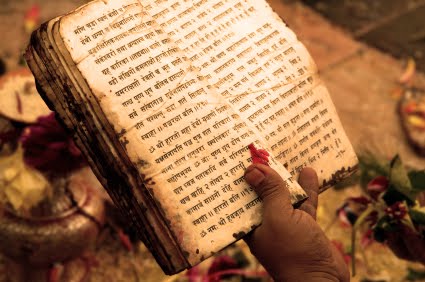
The canonical division of the Védas is fourfold ( turĩya ) viz.,
1. Rigvéda ( RV )
2. Yajurveda ( YV, with the main division TS vs VS )
3. Sāmavéda ( SV )
4. Atharvavéda ( AV )
Of these, the first three were the principal original division, also called "Trayī Vidyā", that is, "the triple sacred science" of reciting hymns ( RV ), performing sacrifices ( YV ), and chanting ( SV ). This triplicity is so introduced in the Brāhmaṇās ( ShB, ABr and others ), but the Rigvéda is the older work of the three from which the other two borrow, next to their own independent Yajus, sorcery and speculative mantras.
Thus, the Mantras are properly of 3 forms :
1. Ric, which are verses of praise in metre, and intended for loud recitation;
2. Yajus, which are in prose, and intended for recitation in lower voice at sacrifices;
3. Sāman, which are in metre, and intended for singing at the Soma ceremonies.
The Yajurveda, Sāmavéda and Atharvavéda are independent collections of mantras and hymns intended as manuals for the Adhvaryu, Udgatr and Brāhmaṇ priests respectively.
The Atharvavéda is the fourth véda. Its status has occasionally been ambiguous, probably due to its use in sorcery and healing. However, it contains very old materials in early Védic language. Manusmrti, which often speaks of the three Védas, calling them trayam-Brāhma-sanātanam, "the triple eternal véda". The Atharvavéda like the Rigvéda, is a collection of original incantations, and other materials borrowing relatively little from the Rigvéda. It has no direct relation to the solemn Shrauta (Śrauta) sacrifices, except for the fact that the mostly silent Brāhmán priest observes the procedures and uses Atharvavéda mantras to 'heal' it when mistakes have been made. Its recitation also produces long life, cures diseases, or effects the ruin of enemies.
Each of the 4 Védas consists of the metrical Mantra or Saṃhitā and the prose Brāhmaṃā part, giving discussions and directions for the detail of the ceremonies at which the Mantras were to be used and explanations of the legends connected with the Mantras and rituals. Both these portions are termed shruti ( which tradition says to have been heard but not composed or written down by men ). Each of the four Védas seems to have passed to numerous Shakhas or schools, giving rise to various recensions of the text. They each have an Index or Anukramani, the principal work of this kind being the general Index or Sarvānukramaṇī.
BRAHMANAS
The mystical notions surrounding the concept of the one "véda" that would flower in védantic philosophy have their roots already in Brāhmaṃā literature, for example in the Shatapatha Brāhmaṃā. The Védas are identified with Brāhmaṇ, the universal principle ( ŚBM 10.1.1.8, 10.2.4.6 ). Vāc "speech" is called the "mother of the Védas" ( ŚBM 6.5.3.4, 10.5.5.1 ). The knowledge of the Védas is endless, compared to them, human knowledge is like mere handfuls of dirt ( TB 3.10.11.3-5 ). The universe itself was originally encapsulated in the three Védas ( ŚBM 10.4.2.22 has Prajapati reflecting that "truly, all beings are in the triple véda" ).
UPANISHADS
The Upanishads are the end part of the Vedas which briefly expound the philosophic principles of the Vedas and are considered the essence of the Vedas. The philosophy of the Upanishads is sublime, profound, lofty and soul-stirring. The Upanishads speak of the identity of the atman (individual soul) and brahman (the Supreme Soul). They reveal the most subtle and deep spiritual truths.
Overview
There is no book in the whole world that is so thrilling, soul-stirring and inspiring as the Upanishad. The philosophy taught by the Upanishads has been the source of solace for many, both in the East and the West. The human intellect has not been able to conceive of anything more noble and sublime in the history of the world than the teachings of the Upanishads.
The Upanishads contain the essence of the Vedas. They are the concluding portions of the Vedas and are the source of the Vedanta philosophy. Profound, original, lofty and sublime thoughts arise from every verse. They contain the direct spiritual experiences or revelations of seers, or sages, the rishi. They are the products of the highest wisdom, supreme divine knowledge. Hence they stir the hearts of people and inspire them.
The glory or grandeur of the Upanishads cannot be adequately described in words, because words are finite and language is imperfect. The Upanishads have indeed greatly contributed to the peace and solace of mankind. They are highly elevating and soul-stirring. Millions of aspirants have drawn inspiration and guidance from the Upanishads. They are the cream of the Vedas. They are treasures of incalculable value. They are rich in profound philosophical thought. Their intrinsic value is very great. There is immense depth of meaning in the passages and verses. The language is beautiful.
The Upanishads give a vivid description of the nature of the Atman, the Supreme Soul, in a variety of ways, and expound suitable methods and aids to attain the Immortal Brahman, the Highest Purusha.
Ages have passed since they were first presented to the world. Even now they are remarkably sweet and charming. Their freshness is unique. Their fragrance is penetrating. Many cannot live today without the study of Upanishads daily. They give supreme food for the soul.
It is said that Schopenhauer, the renowned philosopher of the West, had always a book of the Upanishads on his table, and was in the habit, before going to bed, of performing his devotions from its pages. He said,
The Upanishads have undoubtedly exercised and will continue to exercise a considerable influence on the religion and philosophy of India. They present a view of reality which would certainly satisfy the scientific, the philosophic, as well as the religious aspirations of man.
Origin Of the Upanishads
The Upanishads are metaphysical treatises which are replete with sublime conceptions of Vedanta and with intuitions of universal truths. The Indian Rishis and seers of yore endeavoured to grasp the fundamental truths of being. They tried to solve the problems of the origin, the nature and the destiny of man and of the universe. They attempted to grasp the meaning and value of knowing and being. They endeavoured to find a solution for the problems of the means of life and the world and of the relation of the individual to the ‘Unseen’ or the Supreme Soul. They sought earnestly satisfactory solution of these profound questions: Who am I? What is this universe or Samsara? When are we born? On what do we rest? Where do we go? Is there any such thing as immortality, freedom, perfection, eternal bliss, everlasting peace, Atman, Brahman, or the Self, Supreme Soul, which is birthless, deathless, changeless, self-existent? How to attain Brahman or Immortality?
They practised right living, Tapas, introspection, self-analysis, enquiry and meditation on the pure, inner Self and attained Self-Realization. Their intuitions of deep truths are subtle and direct. Their inner experiences, which are direct, first-hand, intuitive and mystical, which no science can impeach, which all philosophies declare as the ultimate goal of their endeavours, are embodied in the sublime books called the Upanishads.
The Upanishads are the knowledge portion, or Jnana-Kanda, of the Vedas. They are eternal. They came out of the mouth of Hiranyagarbha, or Brahman. They existed even before the creation of this world.
The Upanishads are a source of deep mystic divine knowledge which serves as the means of freedom from this formidable Samsara, earthly bondage. They are world-scriptures. They appeal to the lovers of religion and truth in all races, and at all times. They contain profound secrets of Vedanta, or Jnana-Yoga, and practical hints and clues which throw much light on the pathway of Self-Realization.
There are four Vedas., Rigveda, Yajurveda, Samaveda and Atharvaveda. There are as many Upanishads to each Veda as there are Sakhas or branches (subdivisions). there are 21, 109, 1000, and 50 subdivisions to Rig, Yajur, Sama, and Atharva vedas respectively. Thus there are one thousand and hundred and eighty (1,180) Upanishads.
108 Principal Upanishads
There are total 108 Upanishads according to the Muktika Upanishad. Of these, the following 12 are considered the principle Upanishads. They are:
Another 8, called minor Upanishads, are:
Significance and Ideal
Knowledge of the Upanishads destroys ignorance, the seed of Samsara. 'Shad' means to 'shatter' or 'destroy'. By having knowledge of the Upanishads one is able to sit near Brahman, i.e., to attain Self-realisation. Hence the name 'Upanishad'. Knowledge of Brahman is called 'Upanishad', because it leads to Brahman and helps aspirants to attain Brahman. The term 'Upanishad' is applied to the book also in a secondary sense, by courtesy.
The following two ideas dominate the teaching of all the Upanishads:
(1) Final emancipation can be attained only by knowledge of the Ultimate Reality, or Brahman (Brahmajnana):
(2) He who is equipped with the four means of salvation, viz., Viveka, (discrimination), Vairagya (dispassion), Shad-Sampat (the six-fold treasure; self-control, etc.) and Mumukshutva (yearning for liberation), can attain Brahman.
The Upanishads teach the philosophy of absolute unity.
The goal of men, according to the Upanishads, is realisation of Brahman. Self-Realization alone can dispel ignorance and bestow immortality, eternal bliss, and everlasting peace. Knowledge of Brahman alone can remove all sorrows, delusion and pain.
The Upanishads are rightly called the Vedanta, the end of the Vedas, that which is reserved for those who have freed themselves from the bonds of formal religion.
The Upanishads are not meant for the masses, as they contain the highest speculations of philosophy. They are meant only for the select few, who are fit and worthy to receive the instructions. Hence the term 'Upanishad' signified at first 'secret teaching' or 'secret doctrine'. As already stated, Sadhana-Chatushtaya (the fourfold means) is the primary qualification of an aspirant of Jnana-Yoga, or one who seeks the knowledge of the Upanishads.
Study the Upanishads systematically. Acquire the four means of liberation. Meditate on the non-dual Atman or Brahman and attain ever-lasting Bliss!
LIST OF 108 UPANISHADS
| from Rig Veda | from Shuklapaksha Yajurveda | from Krishnapaksha Yajurveda | from Samaveda | from Atharvaveda |
|---|---|---|---|---|
| 001 Aitareya Upanishad | 011 Adhyatma Upanishad | 030 Akshi Upanishad | 062 Aruni (Aruneyi) Upanishad | 078 Annapurna Upanishad |
| 002 Aksha-Malika Upanishad - about rosary beads | 012 Advaya-Taraka Upanishad | 031 Amritabindhu Upanishad | 063 Avyakta Upanishad | 079 Atharvasikha Upanishad |
| 003 Atma-Bodha Upanishad | 013 Bhikshuka Upanishad | 032 Amritanada Upanishad | 064 Chandogya Upanishad | 080 Atharvasiras Upanishad |
| 004 Bahvricha Upanishad | 014 Brihadaranyaka Upanishad | 033 Avadhuta Upanishad | 065 Darsana Upanishad | 081 Atma Upanishad |
| 005 Kaushitaki-Brahmana Upanishad | 015 Hamsa Upanishad | 034 Brahma-Vidya Upanishad | 066 Jabali Upanishad | 082 Bhasma-Jabala Upanishad |
| 006 Mudgala Upanishad | 016 Isavasya Upanishad | 035 Brahma Upanishad | 067 Kena Upanishad | 083 Bhavana Upanishad |
| 007 Nada-Bindu Upanishad | 017 Jabala Upanishad | 036 Dakshinamurti Upanishad | 068 Kundika Upanishad | 084 Brihad-Jabala Upanishad |
| 008 Nirvana Upanishad | 018 Mandala-Brahmana Upanishad | 037 Dhyana-Bindu Upanishad | 069 Maha Upanishad | 085 Dattatreya Upanishad |
| 009 Saubhagya-Lakshmi Upanishad | 019 Mantrika Upanishad | 038 Ekakshara Upanishad | 070 Maitrayani Upanishad | 086 Devi Upanishad |
| 010 Tripura Upanishad | 020 Muktika Upanishad | 039 Garbha Upanishad | 071 Maitreya Upanishad | 087 Ganapati Upanishad |
| 021 Niralamba Upanishad | 040 Kaivalya Upanishad | 072 Rudraksha-Jabala Upanishad | 088 Garuda Upanishad | |
| 022 Paingala Upanishad | 041 Kalagni-Rudra Upanishad | 073 Sannyasa Upanishad | 089 Gopala-Tapaniya Upanishad | |
| 023 Paramahamsa Upanishad | 042 Kali-Santarana Upanishad | 074 Savitri Upanishad | 090 Hayagriva Upanishad | |
| 024 Satyayaniya Upanishad | 043 Katha Upanishad | 075 Vajrasuchika Upanishad | 091 Krishna Upanishad | |
| 025 Subala Upanishad | 044 Katharudra Upanishad | 076 Vasudeva Upanishad | 092 Maha-Vakya Upanishad | |
| 026 Tara-Sara Upanishad | 045 Kshurika Upanishad | 077 Yoga-Chudamani Upanishad | 093 Mandukya Upanishad | |
| 027 Trisikhi-Brahmana Upanishad | 046 Maha-Narayana (or) Yajniki Upanishad | 094 Mundaka Upanishad | ||
| 028 Turiyatita-Avadhuta Upanishad | 047 Pancha-Brahma Upanishad | 095 Narada-Parivrajaka Upanishad | ||
| 029 Yajnavalkya Upanishad | 048 Pranagnihotra Upanishad | 096 Nrisimha-Tapaniya Upanishad | ||
| 049 Rudra-Hridaya Upanishad | 097 Para-Brahma Upanishad | |||
| 050 Sarasvati-Rahasya Upanishad | 098 Paramahamsa-Parivrajaka Upanishad | |||
| 051 Sariraka Upanishad | 099 Pasupata Brahmana Upanishad | |||
| 052 Sarva-Sara Upanishad | 100 Prasna Upanishad | |||
| 053 Skanda Upanishad | 101 Rama Rahasya Upanishad | |||
| 054 Suka-Rahasya Upanishad | 102 Rama-Tapaniya Upanishad | |||
| 055 Svetasvatara Upanishad | 103 Sandilya Upanishad | |||
| 056 Taittiriya Upanishad | 104 Sarabha Upanishad | |||
| 057 Tejabindu Upanishad | 105 Sita Upanishad | |||
| 058 Varaha Upanishad | 106 Surya Upanishad | |||
| 059 Yoga-Kundalini Upanishad | 107 Tripadvibhuti-Mahanarayana Upanishad | |||
| 060 Yoga-Sikha Upanishad | 108 Tripura-Tapini Upanishad | |||
| 061 Yoga-Tattva Upanishad |
VEDANTA

véda Vyāsa attributed to have compiled the Védas
While contemporary traditions continued to maintain Védic ritualism ( Shrauta (Śrauta), Mimamsa ), Védāṅta renounced all ritualism and radically re-interpreted the notion of "véda" in purely philosophical terms. The association of the three Védas with the bhūr bhuvaḥ svaḥ mantra is found in the Aitareya āraṇyaka: "Bhūḥ is the Rigvéda, bhuvaḥ is the Yajurveda, svaḥ is the Sāmavéda" ( 1.3.2 ). The Upanishad or Upaniṣads reduce the "essence of the Védas" further, to the syllable Aum ( ॐ ). Thus, the Katha Upanishad or Upaniṣads has :
"The goal, which all Védas declare, which all austerities aim at, and which humans desire when they live a life of continence, I will tell you briefly it is Aum" ( 1.2.15 )
Vedānta (Devanagari: वेदान्त) a compound of veda, "knowledge" and anta, "end, conclusion", translating to "the culmination of the Vedas" — is a school of philosophy within Hinduism dealing with the nature of reality. An alternative reading is of anta as "essence", "core", or "inside", rendering the term "Vedānta" — "the essence of the Vedas". It is a principal branch of Hindu philosophy. As per some, it is a form of Jnana Yoga (one of the four basic yoga practices in Hinduism; the others are: Raja Yoga, Bhakti Yoga, Karma Yoga), a form of yoga which involves an individual seeking "the path of intellectual analysis or the discrimination of truth and reality."
Description
All forms of Vedanta are drawn primarily from the Upanishads, a set of philosophical and instructive Vedic scriptures which deal mainly with forms of meditation. "The Upanishads are commentaries on the Vedas, their putative end and essence, and thus known as Vedānta = 'End of the Veda'. They are considered the fundamental essence of all the Vedas and although they form the backbone of Vedanta, portions of Vedantic thought are also derived from some of the earlier Aranyakas.
Indian pre-Shankara Buddhist writer Bhavya in the Madhyamakahrdaya Karika describes the Vedanta philosophy as "Bhedabheda". The three branches of Vedanta best known in the West are Advaita Vedanta, Vishishtadvaita, and dvaita-advaita. Each of these Vedantic divisions was founded by Shri Adi Shankara, Shri Ramanuja and Shri Madhvacharya, respectively. Also of note, historically, in order for a guru to be considered an acharya or great teacher of a philosophical school of Vedanta, he was required to write commentaries on three important texts in Vedanta, the Upanishads, Bhagavad Gita, and the Brahma Sutras. Accordingly, Adi Sankara, Ramanuja and Shri Madhvacharya have written commentaries on all three canonical texts. The three schools they conceived are the most prevalent, however, proponents of other Vedantic schools continue to write and develop their ideas as well, although their works are not widely known outside of India.
POST-VEDIC LITERATURE
VEDANGA
The Védāṅga (Sanskrit: ""Veda-limb; member of the Veda") are six auxiliary disciplines for the understanding and tradition of the Vedas. The four Vedas form the body of the Veda Purusha or the Vedic Being. The six Védāṅgas are the limbs of the Veda Purusha. Four Vedangas govern correct chanting of the Vedas: 1) śikṣā (phonetics), 2) çhandas (meter), 3) Nirukta, "etymology", 4) Vyākaraṇa, "grammar". The two other Vedāngas are 5) Jyotisha Vedanga, "astronomy-astrology" and 6) Kalpa Vedanga, "procedural canon" which includes the Shrauta and Shulba Shastras, "ritual codes", dharma-shastra, "social law" and Grihya Shastras, "domestic codes".
Six technical subjects related to the Védas are traditionally known as Védāṅga "limbs of the véda". V. S. Apte defines this group of works as :
"N. of a certain class of works regarded as auxiliary to the Védas and designed to aid in the correct pronunciation and interpretation of the text and the right employment of the Mantras in ceremonials."
These subjects are treated in Sũtra literature dating from the end of the Védic period to Mauryan times, seeing the transition from late Védic Sanskrit to Classical Sanskrit.
The six subjects of Védāṅga are :
1) Phonetics ( śikṣā )
2) Ritual ( Kalpa )
Kalpa Vedanga or also known as the Kalpa Sutras (Sanskrit: "Procedural or ceremonial Veda-limb") - a body of three groups of auxiliary Vedic texts:
1) the Shrauta Sutras and Shulba Sutras, on public Vedic rites (yagna),
2) the Grihya Sutras (or Shastras), on domestic rites and social custom,
3) the dharma-shastra (or Sutras), on religious law.
Among all the literature related with the Vedanga, Kalpa holds a very prominent and primary place. Kalpa means the scripture, which contains the systematic imagination of all the activities as described in the Vedas. So the Kalpas are the 'precept scriptures' which systematically describe about the various religious activities and ceremonies like Yagya (oblation), marriage and sacred thread ceremony etc propounded by the Vedas. There are numerous sets of Kalpa Sutras, composed by various rishis. Each set is associated with one of the four Vedas.
Description
These aphorisms or precepts are considered as very ancient as its contents have direct relation with the 'Brahmans' and 'Aranyakas'. 'Etareya Aranyak' contains numerous statements which are in fact, in the forms of precepts or aphorisms and which are considered to have been created by 'Ashwalayan' and 'Shaunak'.
'Yagya' (oblation) was the main religious activity of the Vedic Aryans according to the traditions prevalent during the 'Brahmana period' but because of its expanse and vastness, the necessities of precise and systematic scriptures were felt for the use of the performers of the 'Yagya' (oblation).
'Kalpa Sutras' were created to meet this demand and in all the branches of the Vedas.
Kalpa Sutra is mainly of four types:-
SHRAUT SUTRA
1) SHRAUT SUTRA - it contains the description of various religious rites as mentioned in the 'Brahmans' and also the various oblations performed in the sacrificial fire.
Shrauta Shastra or Śrauta Sũtra (Sanskrit: "texts on the revelation")
a) Refers to scriptures or teachings that are in agreement with the Vedas.
b) A specific group of texts of the Kalpa Vedanga, and part of the essential study for Vedic priests.
The Shrauta Shastras offer explanation of the yagna rituals.
R̥gveda
Sāmaveda
Kr̥sna Yajurveda
Śukla Yajurveda
Atharvaveda
GRIHYA SUTRAS / GRIHYA SHASTRAS
2) GRIHYA SUTRAS or GRIHYA SHASTRAS (Sanskrit: "Household maxims or codes") - it contains the detailed description about the various oblations performed in the household like sacred thread ceremony, marriage, 'Shraadh' etc. — an important division of classical smriti literature, designating rules and customs for domestic life, including rites of passage and other home ceremonies, which are widely followed to this day. The Grihya Sutras (or Shastras) are part of the Kalpa Vedanga, "procedural maxims" (or Kalpa Sutras), which also include the Shrauta and Shulba Shastras, on public Vedic rites, and the Dharma Shastras (or Sutras), on domestic-social law. Among the best known Grihya Sutras are Ashvalayana's Grihya Sutras attached to the Rig Veda, Gobhila's Sutras of the Sama Veda, and the Sutras of Paraskara and Baudhayana of the Yajur Veda.
DHARMA SUTRA
3) DHARMA SUTRA - it contains the detailed description about the duties of all the four castes i.e. Brahmin, Kshatriya, Vaishya and Shudra. The duties of the king are especially emphasized. It is considered as the main 'Kalpa Sutra'.
Dharma Shastra or Dharmaśāstra (Sanskrit: धर्मशास्त्र, "Religious law book.") — a term referring to all or any of numerous codes of Hindu civil and social law composed by various authors. The best known and most respected are those by Manu and Yajnavalkya. The Dharma Shastras are part of the Smriti literature, included in the Kalpa Vedanga, and are widely available today in many languages.
The Dharma Shastras, along with the Artha Shastras, are the codes of Hindu law, parallel to the Muslim Sharia, the Jewish Talmud, each of which provides guidelines for kings, ministers, judicial systems and law enforcement agencies. These spiritual-parliamentary codes differ from British and American law, which separate religion from politics. (Contemporary British law is influenced by Anglican Christian thought, just as American democracy was, and is, profoundly affected by the philosophy of its non-Christian, Deistic founders.) The Dharma Shastras also speak of much more, including creation, initiation, the stages of life, daily rites, duties of husband and wife, varnasrama, Vedic study, penances and transmigration.
Description
Written after the DharmaSũtras, these texts use a metered verse and are much more elaborate in their scope. Scholars have postulated that these texts are actually compilations of common gnomic verses of the times, known by the śiṣṭas. Such verses were regularly cited as legitimation for legal judgments and advice. At some point these verses were gathered together into complete texts under the name of particular sages. These texts are said to have been edited and updated with additions of verses which had not previously been included. However, there is an ongoing debate amongst scholars regarding this matter. Other scholars refute the multiple authorship idea, claiming that the major texts were written by a single author at a particular time in history and remained relatively unedited as time went by. Regardless, by attributing their authorship to that of well known sages like Nārada, the text takes on a superior authority. The most influential texts are listed below, along with their approximate dates:
Content
All Dharmaśāstra derives its authority with reference to the Vedas, though few, if any, of the contents of most Dharmaśāstra texts can be directly linked with extant Vedic texts. Traditionally, Dharmaśāstra has, since the time of the Yājñvalkyasmṛti, been divided into three major topics:
1) ācāra, rules pertaining to daily rituals, life-cycle rites, and other duties of four castes or varṇas,
2) vyavahāra, rules pertaining to the procedures for resolving doubts about dharma and rules of substantive law categorized according the standard eighteen titles of Hindu law,
3) prāyaŚcitta, rules about expiations and penances for violations of the rules of dharma.
SHULBA SUTRA
4) SHULBA SUTRA - it contains the methods of constructing the 'Altar' of the oblation which are based on the ancient geometrical science of the Aryans and which are considered to be very scientific.
The main subject of the Shraut Sutra is the description of the various oblations as propounded by the Vedas. The names of these Vedas are as follows:-
a) SOMYAGYA, b) VAAJAPEYA, c) RAJSUYA, d) ASHWAMEDHA etc
According to the 'Shraut Sutra' all the rituals of the oblations are performed only after igniting fire. Hence great emphasis has been given on the selection of the sacrificial fire and its re-ignition in some special circumstances. Due to their complexities the Shraut Sutras do not find any interest in the general people but their religious importance is incomparable.
Rigveda has two 'Shraut Sutras'- Ashwatayan and Shankhayan. In both of them various oblations are described which are performed by the performer with a specific purpose.
There are twelve chapters in the Ashwalayan Shraut Sutra. It is a well known fact that sage Ashwalayan was sage Shaunak's disciple and it is also believed that the last two chapters of the 'Etareya Aranyak' were the works of both of them.
Similarly the 'Shankhayan Shraut Sutra' has eighteen chapters and it has detailed description of the methods of performing the various oblations. 'Shankhayan Shraut Sutra which is related with the 'Brahmana' seems to be most ancient of all the 'Shraut Sutras' going by the contents and style of narration and it also has similarities with the 'Brahmana' to some extent. The last two chapters of its eighteen chapters are believed to be a later edition and which have similarities with the first two chapters of the 'Kaushitaki Aranyak' in its contents.
SHUKLA YAJURVEDIYA KALPASUTRA
SHUKLA YAJURVEDIYA KALPASUTRA: There are two 'precept scriptures' on the Shukla Yajurveda :
The knowledge of the contents of 'Katyayan Shraut Sutra' is essential for understanding the 'Shraut Sutra'. Katyayan Shraut Sutra is considered as a scripture representing the Shraut Sutra. Katyayan Shraut Sutra has been written in the mode of the precepts and aphorisms and is classified into 26 chapters which has a detailed description of the various types of oblations.
The first chapter of Katyayan Shraut Sutra' which consists of ten 'Kandikas' (subdivisions) describes about the characteristics of the various subjects related with oblations.
The second and third chapters which consist of eight 'Kandikas' each give the complete description of the oblations performed on the 'dark moon' and 'full moon' days. The first 'Kandika' of the second chapter gives information about the initial ceremonies and the last Kandika of the third chapter sheds light on the 'main ceremonies' or the 'main oblations'. The fourth chapter which consists of 15 'Kandikas' describe about the various oblations like 'PINDA PITRA YAGYA', 'DAKSHAYAN YAGYA', 'SHRAUT YAGYA' and 'AGNIHOTRA YAGYA' respectively.
The fifth chapter which consists of 13 Kandikas describes about the oblations and rites performed during the month of 'Chaturmasya' in great detail.
The sixth chapter which consists of 10 'Kandikas' describes about the methods of sacrificing animals.
From the seventh chapter to the tenth chapter there is a complete description of 'AGNISHTOMA YAGYA'. The seventh and eighth chapter contain the various ceremonies which are performed prior to the performance of 'AGNISHTOMA YAGYA', the ninth chapter contains the various rituals performed during the early morning and the tenth chapter describes about the various rituals performed during the noon time and during the evening time.
The eleventh chapter contains the detailed description of the works of a sacrificial priest named Brahma and the importance of his works.
Similarly the twelfth chapter contains the description about the 'DWAADASHAAHA YAGYA', the thirteenth chapter about the 'GAWAMAYAN YAGYA', the fourteenth chapter about the 'VAAJAPEYA YAGYA' and the fifteenth chapter contains the description about the 'RAAJASUYA YAGYA'.
From the sixteenth chapter to the eighteenth chapter there is a detailed description about the selection of the sacrificial fire (agnichayan).
Similarly the nineteenth chapter contains the detailed description about 'SAVTARAMANI', the twentieth chapter about the ASWAMEGHA, the twenty-first chapter about the 'PURUSHMEGHA', the 'SARVAMEGHA' and 'PITRAMEGHA YAGYA'.
The subject matters of the chapters from twenty second to twenty fourth are 'EKAHA' (oblation completed in one day), 'AHEEN' (oblation which gets completed within two to eleven days) and 'SATRA YAGYA'. The base of this section is 'TANDAYA MAHABRAHMAN' which is considered to be the main 'Brahmana' of the SAMAVEDA and hence has been appropriately adjusted in the 'SHUKLA YAJURVEDIYA BRAHMAN'.
The twenty-fifth chapter describes about the various methods of atonement for the mistakes committed during the process of oblation.
The last chapter (26th chapter) describes about 'PRAVARGYA' (classification of all the subjects).
PARASKAR GRIHYA SUTRA: The Grihya Sutra of Shukla Yajurveda is also known as Paraskar Grihya Sutra. It has been divided into three 'Kandas'.
The first 'Kanda' contains the description of 'Awasathya-Agni'. (name of a special kind of sacrificial fire) and its conception, marriage ceremony, conception of a child and 'ANNAPRASHAN' (a ceremony in which a child is given for the first time rice cooked in milk) rite which is performed on the return of the disciple to his household after finishing his studies), 'Panchamaha Yagya' (five essential duties of a householder), 'Shravanakarm' (listening to the scriptures) and Sita Yagya.
The third and the last Kanda contains the description about 'Shraadh' (act of devotion to the names) and atonement for the mistakes committed during the 'Shraadh' etc.
KRISHNA YAJURVEDA
KRISHNA YAJURVEDA: The following 'Shraut Sutras' are available which are related to 'Krishna Yajurveda'. They are:-
1. Baudhayan Shraut Sutra.
2. Apastamba Shraut Sutra.
3. Hiranyakeshi Shraut Sutra or Sanyashadha.
4. Vaikhanus Shraut Sutra.
5. Bhardwaj Shraut Sutra.
6. Manav Shraut Sutra.
The first five of these Sutras are related to the branch of 'Taitereya' and the last one is related to the branch of 'Maitrayani'. Baudhayan Shraut Sutra and Apastamba Shraut Sutra have the complete details of all the four precept scriptures (sutra grantha) of the Kalpa i.e. Shraut, Grihya Dharma and Shulva.
SAMVEDIYA KALPASUTRA
SAMVEDIYA KALPASUTRA: Among the 'Kalpa sutras' which are related with 'SAMVEDA ARSHEYA KALPA is considered to be the supreme. A sage by the name of Mashak is supposed to be the creator of this Kalpa Sutra. This enormous scripture contains eleven chapters. The main objective of this text is to show as to which 'Sama' (versus of Samaveda) is to be sung in which oblation.
There are three types of SOM YAGYA. They are as under:-
1. EKAHA:- which gets completed within a day.
2. AHEENA:- which gets completed within two days to eleven days.
3. SATRA:- which takes at least twelve days and at the most one year for completion.
Arsheya Kalpa is related to 'Tandya-Maha-Brahman' i.e. the order in which it describes about the oblations of the Samavediya Brahmana, the same order has been initiated by this Kalpa Sutra. The applications of different modes of the singing of 'Samas' (verses of Samveda) during the performance of Soma Yagya is described in detail and is the specialty of the Arsheya Kalpa.
3) Grammar ( Vyākaraṇa )
Vyākaraṇa Vedanga or Vyākaraṇa Shastra (Sanskrit: "grammar") — auxiliary Vedic texts on Sanskrit grammar. Vyakarana is among four linguistic skills taught for mastery of the Vedas and the rites of yagna. The term literally means "separation, or explanation." The most celebrated Vyakarana work is Panini's 4,000-sutra Ashtadhyayi, which set the linguistic standards for classical Sanskrit.
Words by themselves may not mean much, unless there are set rules as to their usage and more rules for their usage in combinations, forming sentences. Vyakarana performs the important function of imparting significance to Veda Vakyas. For each Shastra, there is a bhashya (just as there is the Sri Bhashya for Brahmasutras). The greatness of the Vyakarana Vedanga would be evident when we note that its bhashya is known simply as the "Maha Bhashya" (authored by Patanjali Rishi, based on the Sutras of Panini).
4) Etymology ( Nirukta )
Nirukta Vedanga (Sanskrit: "etymology Veda-limb.") — auxiliary Vedic texts which discuss the origin and development of words; among the four linguistic skills taught for mastery of the Vedas and the rites of yagna. Nirukta relies upon ancient lexicons, nighantu, as well as detailed hymn indices, anukramani. Five nighantus existed at the time of sage Yaska, whose treatise is regarded a standard work on Vedic etymology.
Description
There are altogether fourteen chapters in Nirukta out of which the first twelve chapters from the beginning are the main chapters and the two chapters in the end are given in the form of appendixes or supplementaries. These last two chapters can not be considered as a subsequent addition because sage Uvvat in his annotation of Yajurveda has taken excerpts from the Nirukta. Both he and sage ?Sayan? are well acquainted with the chapters of Nirukta. This goes to prove that the Nirukta is more ancient than the time when both these sages existed.
Nirukta is the commentary of Nighantu. In Nighantu are compiled the difficult and complex terms of the Vedas. There are difference of opinions regarding the actual numbers of Nighantu. Only one Nighantu is available nowdays. Some scholars are of the views that Nidhantu is created by none other than Yask, but followers of ancient tradition. According to the Mahabharat (Ch-342 of Moksha dharm Shlokas 86-87) sage Kashyap is the creator of Nighantu.
Therefore going by the statement made in the Mahabharat it seems that it was the creation of Prajapati Kashyap during the Mahabharat period. There are five chapters in Nighantu. The first three chapters from the beginning are called ?Naighantukand?, the fourth and the fifth chapter are called Naigam kand and Daivatkand respectively.
The first chapter contains words connected with nature and natural elements like earth. The second kand consists of root-words or mono-words.
The word Naigam means the impossibility to know about the exact meaning of the words and their nature.
In Daivat-kand is described the appearances of the deities and their abodes.
Nirukta tells us about the etymological expressions of words & its derivations. The meaning varies according to the etymological expressions.
Important of the Nirukta
The important of the Nirukta created by Yask is very great. In the very beginning of his literary composition sage Yask has illustrated about the principle of Nirukta in a scientific way. During his time the meanings of Vedas were interpreted on the basis of diverse opinions, which were as follows.
1. Adhidaivat
2. Adhyatm
3. Aakhyan Samay
4. Ethihasikah
5. Naidanah
6. Nairuktah
7. Parivrajahah
8. Yagyikah
These above mentioned various opinions shed light on the history of different contemplation?s of the Vedas.
Sage Yask had a great impact on many commentators of the Vedas in due course of time. Sage Sayan accomplished his commentaries of the Vedas after contemplating on his very system. Yask's processes are also accepted and followed by the linguists of modern age. Being the sole representative of the Nirukta, the importance of Yasks volume is great.
Although Nirukta is itself is a commentary of the Vedas, but still, it is so complex at certain places that even the most learned commentators fail to understand its real meaning. Moreover the exact chapter of Nirukta are nor available traditionally. Along with the difficult language which the Nirukta contains its chapters are so complex at certain places that even a great annotator like Durgacharya experienced difficulty in understanding it. Because of its complex nature many scholars, before Vikram have tried their hands at writing commentaries on it.
Commentators of Nirukta
1) DURGACHARYA: Durgacharya is one of the most ancient commentator of the Nirukta, but he is certainly not the first one to do so. Numerous commentaries of earlier annotators are mentioned in his volume.
2) SKAND MAHESHWAR: This commentary is very ancient and scholarly. Commentary on the Rigveda is also available.
Importance of Nirukta
The term "Nirukta" has been described by sage Sayanacharya in the following way
"ARTHAVABODHE NIRPEKSHATAYA PADJATAM YATRA TAT NIRUKTAM"
The collection of independent words which helps in understanding their meaning are called Nirukta.
Durgacharya is of the opinion that Nirukta is supreme among the Vedanga and volumes because it helps us to understand the meaning of the words. The meaning of the word is of primary importance and the word itself is of secondary importance. Grammar is nothing but the study of the words. In ?Kalps? (part of Veda treating of rituals) the proper use of the Mantras in the vedic ceremonies are described. The mantra is used only in such situation where the words contained in that mantra is capable of expressing themselves completely. Therefore Kalpa too helps in gaining knowledge of mantras meaning.
Nirukta is of greater value than Kalpa because it helps in understanding the meanings of words, in all of their probable permutations and combinations, where as Kalpa helps to understand the meanings of mantras, which themselves consist of words.
Although the study of grammar also helps in understanding the characteristics of words but I can not interpret the meaning of words as deeply as Nirukta. Therefore the study of the Nirukta is very necessary to understand the Vedas. It is a supplementary science of Grammar.
5) Meter ( Çhandas )
Çhandas Vedanga (Sanskrit: "meter") - auxiliary Vedic texts on the metrical rules of poetic writing. çhanda is among four linguistic skills taught for mastery of the Vedas and the rites of yagna. çhandas means "desire; will; metrical science." The most important text on çhandas is the Çhanda Shastra, ascribed to Pingala. Its knowledge is most essential for the correct pronunciation of the Vedic mantras.
Just as the knowledge of the internal system of the human-body is most essential for a physician, in the similar way the knowledge of çhand is most essential for a 'Vaidic' (one who studies the Veda). Without its appropriate knowledge the mantras of Vedas can never be correctly pronounced. The knowledge of deity, sage, and çhand is very essential for each Sukta (Vedic text, collection of mantras) of the Veda. Sage Katyayan has clearly stated that, one who studies or chants the mantras; or teaches them to others; or performs oblation without having the appropriate knowledge of its çhand, 'Sage' and the deity, all of his objectives remain unfulfilled.
DescriptionThe names of the main çhand are available in the Sanhita and the Brahmanas. This goes to prove that, this organ i.e. çhand already existed even during the Vedic period. Chand Sutra is the representative volume of this 'Organ' of the Veda, created by Sage Pingalacharya. This volume is written in the form of precept and is classified into eight chapters. From the beginning and till the seventh 'Sutra' (precept) of the fourth chapter, the characteristics of Vaidic Çhand are described. After that there are descriptions of general Chand (Laukik Chhand).
The binding of stanzas are meters in the Laukik Chhand are not as strict in its prose form, as it in its. Verse form. But in the 'Vaidic-Chhand' the purity of the stanzas and meters are strictly applied. In the Nirukta it has been stated that-
"NACHCHHANDAI VAGUCHCHARIT"
Without the Chhand (stanza), one ca not even pronounce.
Even Sage Bharat has declared that there is no existence of word without the stanza (Chhand).
Katyayan has accepted the above mentioned fact-
CHHANDOBHUTMIDAM SARVAM VANGMAY SYAT VIJANATAH|
NACHCHHAND NA CHAPRISHTE SHABDASHCHARATIKASHCHAN||All the saying of this whole world are bound by the 'Chhand'. There is no word, which is different from it.
The above statements clearly show that not a single mantra of the Veda is created without the Chhand. Therefore, it can be said that even the mantras of the Yajurveda, which has been written in prose form, are not devoid of the 'Chhand'. The ancient preceptors have classified 'Chhandas' consisting of one letter to one hundred and four letters.
All the mantras of Rigveda and Samveda, which are also known as 'Richas', are written in the form of stanzas.
Chhand is the natural medium to express the finer emotions of the heart. The poets try to find the body for the soul (poetry) by the help of Chhand. The chief objective of the mantra if to please the deity, during the oblation. The chanting of the mantras are undoubtedly the chief medium of pleasing the deities. In this regard, the importance of Chhand is obvious.
According to Yask, the term Chhand is derived from the root 'Chhand' which means to cover up. So, Chhand are the coverings by which the Vedas remain covered.
One of the main characteristics of the Vaidic Chhand are that normally all of them are based on the calculation of letters or alphabets. This implies that they do not follow the rule of 'sequence of the major or minor form of the letters'.
According to the scriptures there are two types of Chhand-
1. Varnik Chhand (alphabetical stanzas)
2. Matrik Chhand (stanzas containing short vowels)
In the Vedas, we normally find the former type of Chhand. The descriptions of Chhand of each 'Samhita' are minutely described in the contexts of 'Pratishakhya'. Katyayan has authentically instructed about the Chhand of each mantra of Rigveda in 'Sarvanukramam'.
'Chhand' has been extensively described in Pratishakhya, especially Rik-Pratishakhya (Patal 16-18) similarly it also contains described of other Vaidic Chhands.
6) Astronomy ( Jyotiṣa )
Jyotisha Vedanga (Sanskrit: "Veda-limb of celestial science or astronomy-astrology") - ancient texts giving knowledge of astronomy and astrology, for understanding the cosmos and determining proper timing for Vedic rites.
PARISISTA
Pariśiṣṭa "supplement, appendix" is the term applied to various ancillary works of Védic literature, dealing mainly with details of ritual and elaborations of the texts logically and chronologically prior to them: the Saṃhitās, Brāhmaṇās, Āraṇyakas and Sũtras. Naturally classified with the véda to which each pertains, Pariśiṣṭa works exist for each of the 4 Védas. However, only the literature associated with the Atharvavéda is extensive.
PURANAS
A traditional view given in the Vishnu Purana ( likely dating to the Gupta period ) attributes the current arrangement of 4 Védas to the mythical sage véda Vyāsa. Puranic tradition also postulates a single original véda that, in varying accounts, was divided into 3 or 4 parts. According to the Vishnu Purana ( 3.2.18, 3.3.4 etc. ) the original véda was divided into 4 parts, and further fragmented into numerous shakhas, by Lord Vishnu in the form of Vyāsa, in the Dvapara Yuga; the Vayu Purana ( section 60 ) recounts a similar division by Vyāsa, at the urging of Brāhma. The Bhagavata Purana ( 12.6.37 ) traces the origin of the primeval véda to the syllable aum, and says that it was divided into 4 at the start of Dvapara Yuga, because men had declined in age, virtue and understanding. In a differing account Bhagavata Purana ( 9.14.43 ) attributes the division of the primeval véda ( aum ) into 3 parts to the monarch Pururavas at the beginning of Treta Yuga. The Mahābhārata ( santiparva 13,088 ) also mentions the division of the véda into 3 in Treta Yuga.
Purana (Sanskrit: पुराण purāṇa, meaning "belonging to ancient or olden times") is the name of an ancient Indian genre (or a group of related genres) of Hindu literature (as distinct from oral tradition). Its general themes are history, tradition and religion. While the major puranas are in Sanskrit, puranas exist in other Indian languages also. It is usually written in the form of stories related by one person to another.
Overview
There are many texts designated as 'Purana.' The most important are:
According to tradition, the Puranas were composed by Vyasa at the end of Dvapara Yuga.
The Darsanas are very stiff. They are meant only for the learned few. The Puranas are meant for the masses with inferior intellect. Religion is taught in a very easy and interesting way through these Puranas. Even to this day, the Puranas are popular. The Puranas contain the history of remote times. They also give a description of the regions of the universe not visible to the ordinary physical eye. They are very interesting to read and are full of information of all kinds. Children hear the stories from their grandmothers, Pandits and Purohits (priests) hold Kathas in temples, on banks of rivers and in other important places. Agriculturalists, labourers and bazaar people (common masses) hear the stories.
Mahāpurāṇas and Upapurāṇas
Mahāpurāṇas and Upapurāṇas, the main Puranic corpus Mahapuranas are deemed to be the upper corpus of Puranas.
Traditionally there are 18 Maha-puranas. Each Maha-purana lists eighteen canonical puranas, but the contents of each list vary reflecting differences in time and place. These eighteen maha-puranas are divided into three groups and each group has six texts.
The Mahapuranas is a description of the Hindu trinity lords namely, Brahma, Vishnu and Shiva. Since all three are important gods, all these are given due emphasis in any Purana. But the relative emphasis often varies from Purana to Purana.
Classification of Maha-puranas:
Vaishnava classification by guna
Of the Mahapuranas it is said that six belong to the quality (guna) of goodness, six to passion, and six to ignorance. According to the Padma Purana, these are the Mahapuranas and their corresponding qualities:
The author of Mahapuranas
The Puranas were composed by sage vyasa - the narrator of Mahabharata. The texts, the scholars say, were probably written all over India and are being rewritten and reedited to the present day all over the world.
The term purana, which means "belonging to ancient times" or "an ancient tale or legend," appears in the Vedas. The specific corpus of the Mahapuranas, as opposed to generic purana "ancient tale", are generally estimated to date to the Early Middle Ages, or to roughly between the 5th and 10th centuries, but may contain older material.
Puranic genealogies
The Puranas also lay emphasis on keeping a record of genealogies. Vayu Purana once stated that, "As seen by good people in the ancient times the suta's duty was to preserve the genealogies of gods and glorious kings and the traditions of great men". The Puranic genealogies add up to fantastic time depths. The Vedic and Puranic genealogies indicate a greater antiquity of the Vedic culture.
The Five Characteristics of purāṇas
The Puranas are of the same class as the Itihasas and are classified into a Mahā- ("great") and a Upa- ("lower, additional") corpus. According to Matysa Purana, they are said to narrate and deal systematically with five subjects, called Pancha Lakshana pañcalakṣaṇa ("five distinguishing marks"):
Most Mahapuranas and Upapuranas deal with these subject matters, although the bulk of their text consists of historical and religious narratives. A Purana usually gives prominence to a certain deity (Shiva, Vishnu or Krishna, Durga). Most use an abundance of religious and philosophical concepts in their narration, from Bhakti to Samkhya.
The Eighteen Upa-Puranas
There are eighteen main Puranas and an equal number of subsidiary Puranas or Upa-Puranas. The main Puranas are:
Of these, six are Sattvic Puranas and glorify Vishnu; Six are Rajasic Puranas and glorify Brahma; six are Tamasic Puranas and glorify Siva.
Neophytes or beginners in the spiritual path are puzzled when they go through Siva Purana and Vishnu Purana. In Siva Purana, Lord Siva is highly eulogised and an inferior position is given to Lord Vishnu. Sometimes Vishnu is belittled. In Vishnu Purana, Lord Hari (Vishnu) is highly eulogised and the inferior status is given to Lord Siva. Sometimes Lord Siva is belittled. This is only to increase the faith of the devotees in their particular Ishta-Devata (favourite or tutelary deity). Lord Siva and Lord Vishnu are one.
The best among the Puranas are the Srimad Bhagavata and the Vishnu Purana. The most popular is the Srimad Bhagavata Purana. Next comes Vishnu Purana. A portion of the Markandeya Purana is well known to all Hindus as Chandi, or Devimahatmya. Worship of God as the Divine Mother is its theme. Chandi is read widely by the Hindus on sacred days and Navaratri (Durga Puja) days.
Other Puranas
Besides the two major types of puranas namely the Maha-puranas and Upa-puranas, there are other two Hindu puranas namely, Sthala puranas, Kula puranas and others.
Sthala puranas: These texts narrates the virtues and stories connected with a certain temple or shrine (the word 'Sthala' means 'Place' in Sanskrit). There are numerous Sthala Puranas, most written in vernaculars, some with Sanskrit versions as well. Most claim to have a Sanskrit origin, and some of the Sanskrit versions also appear in a Mahapurana or an Upapurana.
Kula puranas: These puranas are caste or family oriented. They deal with a caste's origin myth, stories and legends. The kula puranas is of uttermost importance as it is an important source for caste identity and is usually contested by other, rival, castes. This subgenre is usually in the vernacular language and might at times be oral.
Other puranas: There are many other narratives that go by the name of Purana. Most are written in vernaculars and are usually concerned with mythical and historical narrations. These texts, such as the Padma Purana of Bengal and Assam (narrating the story of the goddess Manasa), are vast in number and scattered all over the Indian subcontinent.
Utility of the Puranas
Study of the Puranas, listening to sacred recitals of scriptures, describing and expounding of the transcendent Lilas (divine sports) of the Blessed Lord – these form an important part of Sadhana (spiritual practice) of the Lord's devotee. It is most pleasing to the Lord. Sravana (hearing of the Srutis or scriptures) is a part of Navavidha-Bhakti (nine modes of devotion). Kathas (narrative or story) and Upanyasas open the springs of devotion in the hearts of hearers and develop Prema-Bhakti (divine love for God) which confers immortality on the Jiva (individual soul).
[Note: The nine modes of devotion are: Hearing His (God's) names and glories, singing them, remembering the Lord, worship (service) of His Feet, adoration with flowers, prostrations, regarding oneself as His servant, as His friend, and total self-surrender.]
The language of the Vedas is archaic, and the subtle philosophy of the Vedanta and the Upanishads is difficult to grasp and assimilate. Hence, the Puranas are of special value as they present philosophical truths and precious teachings in an easier manner. They give ready access to the mysteries of life and the key to bliss. Imbibe their teachings. Start a new life of Dharma-Nishtha and Adhyatmic Sadhana from this very day.
[Note; Dharma-Nishtha = steadfastness or establishment in Dharma. Adhyatmic (pertaining to the Inner Self) Sadhana (spiritual practice)]
Translations
The Puranas are available in vernacular translations and are disseminated by Brahminscholars, who read from them and tell their stories, usually in Katha sessions (in which a travelling brahmin settles for a few weeks in a temple and narrates parts of a Purana, usually with a bhakti perspective).
The Tamil Puranas
Lord Siva incarnated Himself in the form of Dakshinamurti to impart knowledge to the four Kumaras. He took human form to initiate Sambandhar, Manikkavasagar and Pattinathar. He appeared in flesh and blood to help his devotees and relieve their sufferings. The divine Lilas (sports) of Lord Siva are recorded in the Tamil Puranas like Siva Purana, Periya Purana, Siva Parakramam and Tiruvilayadal Purana.
UPAVEDA
The term Upavéda ( "applied knowledge" ) is used in traditional literature to designate the subjects of certain technical works. Lists of what subjects are included in this class differ among sources. The Charanavyuha mentions four UpaVédas:
But Sushruta and Bhavaprakasha mention Áyurveédic as an Upavéda of the Atharvavéda. Sthapatyavéda ( architecture ), Shilpa Śāstras ( arts and crafts ) are mentioned as fourth Upavéda according to later sources.
"FIFTH" AND OTHER VEDAS
Some post-Védic texts, including the Mahābhārata, the Natyaśāstra and certain Puranas, refer to themselves as the "fifth véda". The earliest reference to such a "fifth véda" is found in the Chandogya Upanishad or Upaniṣads. "Dravida véda" is a term for canonical Tamil Bhakti texts.
Other texts such as the Bhagavad Gita or the Védāṅta Sũtras are considered shruti or "Védic" by some Hindu denominations but not universally within Hinduism. The Bhakti movement, and Gaudiya Vaishnavism in particular extended the term véda to include the Sanskrit Epics and Vaishnavite devotional texts such as the Pancaratra.
WESTERN INDOLOGY
The study of Sanskrit in the West began in the 17th century. In the early 19th century, Arthur Schopenhauer drew attention to Védic texts, specifically the Upanishad or Upaniṣads. The importance of Védic Sanskrit for Indo-European studies was also recognized in the early 19th century. English translations of the Saṃhitās were published in the later 19th century, in the Sacred Books of the East series edited by Müller between 1879 and 1910. Ralph T. H. Griffith also presented English translations of the four Saṃhitās, published 1889 to 1899.
BACK TO PAGE
Notes
READ MORE
English pronunciation : véda / Vētā / Vētam / Vēdham āyvukaḷ / ñāṉam Vaḷarcci Peṟa / Rikvēdaṁ / Rik vētam / Yajūr vētam / Sāma vētam / Atarvaṉa vētam /
Sanskrit संस्कृतम् : वेद /
Tamil தமிழ் : வேதா / வேதம் ஆய்வுகள் / ஞானம் வளர்ச்சி பெற / ரிக் வேதம் / யஜூர் வேதம் / சாம வேதம் / அதர்வன வேதம்
Bahasa Melayu : Rigvéda / Yajurveda / Sāmavéda / Atharvavéda /
Malayalam : not_available /
Telugu : రుగ్వేదం ( Rugvēdaṁ ) / యజుర్వేదం ( Yajurvēdaṁ) / సామవేదం ( Sāmavēdaṁ ) / అధర్వ వేదం ( Adharva vēdaṁ ) /
Français : not_available
Introduction
Rigvéda ( padapatha ) manuscript in Devanagari, early 19th century
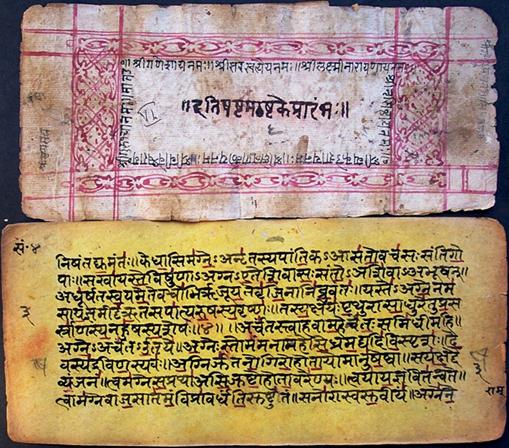
Rigvéda collection of Bhandarkar Oriental Research Institute, Pune
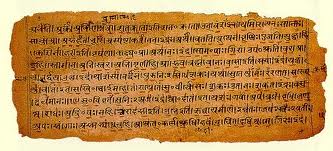

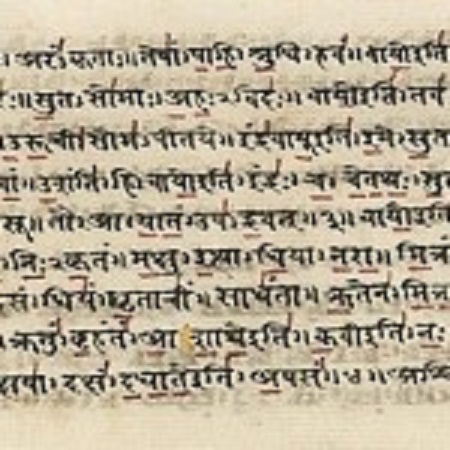
The Rigvéda ( Sanskrit : ऋग्वेद ṛgvéda, a compound of ṛc "praise, verse" and véda "knowledge" ) is an ancient Indian sacred collection of Védic Sanskrit hymns. It is counted among the four canonical sacred texts ( Śruti ) of Hinduism known as the Védas. Some of its verses are still recited as Hindu prayers, at religious functions and other occasions, putting these among the world's oldest religious texts in continued use. The Rigvéda contains several mythological and poetical accounts of the origin of the world, hymns praising the gods, and ancient prayers for life, prosperity, etc.
It is one of the oldest extant texts in any Indo-European language. Philological and linguistic evidence indicate that the Rigvéda was composed in the north-western region of the Indian subcontinent, roughly between 1700–1100 BC ( the early Védic period ).
The Rigvéda Saṃhitā is the oldest extant Indic text. It is a collection of 1,028 Védic Sanskrit hymns and 10,600 verses in all, organized into ten books ( Sanskrit : mandalas ). The hymns are dedicated to Rigvédic deities.
The books were composed by poets from different priestly groups over a period of several centuries, commonly dated to the period of roughly the second half of the 2nd millennium BCE ( the early Védic period ) in the Punjab ( Sapta Sindhu ) region of the Indian subcontinent.
There are strong linguistic and cultural similarities between the Rigvéda and the early Iranian Avesta, deriving from the Proto-Indo-Iranian times, often associated with the Andronovo culture; the earliest horse-drawn chariots were found at Andronovo sites in the Sintashta-Petrovka cultural area near the Ural Mountains and date to ca. 2000 BCE.
Text
The surviving form of the Rigvéda is based on an early Iron Age ( c. 10th c. BC ) collection that established the core 'family books' ( mandalas 2-7, ordered by author, deity and meter ) and a later redaction, co-eval with the redaction of the other Védas, dating several centuries after the hymns were composed. This redaction also included some additions ( contradicting the strict ordering scheme ) and orthoepic changes to the Védic Sanskrit such as the regularization of sandhi ( termed orthoepische Diaskeuase by Oldenberg, 1888 ).
As with the other Védas, the redacted text has been handed down in several versions, most importantly the Padapatha that has each word isolated in pausa form and is used for just one way of memorization; and the Saṃhitāpatha that combines words according to the rules of sandhi ( the process being described in the Pratisakhya ) and is the memorized text used for recitation.
The Padapatha and the Pratisakhya anchor the text's fidelity and meaning and the fixed text was preserved with unparalleled fidelity for more than a millennium by oral tradition alone. In order to achieve this the oral tradition prescribed very structured enunciation, involving breaking down the Sanskrit compounds into stems and inflections, as well as certain permutations. This interplay with sounds gave rise to a scholarly tradition of morphology and phonetics. The Rigvéda was probably not written down until the Gupta period ( 4th to 6th century AD ), by which time the Brāhmi script had become widespread ( the oldest surviving manuscripts date to the Late Middle Ages ). The oral tradition still continued into recent times.
The original text ( as authored by the Rishis ) is close to but not identical to the extant Saṃhitāpatha, but metrical and other observations allow to reconstruct ( in part at least ) the original text from the extant one, as printed in the Harvard Oriental Series, vol. 50 ( 1994 ).
Organisation
The text is organized in 10 books, known as Mandalas, of varying age and length. The "family books": mandalas 2–7, are the oldest part of the Rigvéda and the shortest books; they are arranged by length and account for 38% of the text. The eighth and ninth mandalas, comprising hymns of mixed age, account for 15% and 9%, respectively. The first and the tenth mandalas are the youngest; they are also the longest books, of 191 Sūktas each, accounting for 37% of the text.
Each mandala consists of hymns called sūkta ( su-ukta, literally, "well recited, eulogy" ) intended for various sacrificial rituals. The sūktas in turn consist of individual stanzas called ṛc ( "praise", pl. ṛcas ), which are further analysed into units of verse called pada ( "foot" ). The meters most used in the ṛcas are the jagati ( a pada consists of 12 syllables ), trishtubh ( 11 ), viraj ( 10 ), gayatri and anushtubh ( 8 ).
For pedagogical convenience, each mandala is synthetically divided into roughly equal sections of several sūktas, called anuvāka ( "recitation" ), which modern publishers often omit. Another scheme divides the entire text over the 10 mandalas into aṣṭaka ( "eighth" ), adhyāya ( "chapter" ) and varga ( "class" ). Some publishers give both classifications in a single edition.
The most common numbering scheme is by book, hymn and stanza ( and pada a, b, c..., if required ). E.g., the first pada is
Recensions
The major Rigvédic shakha ( "branch", i. e. recension ) that has survived is that of Śākalya. Another shakha that may have survived is the Bāṣkala, although this is uncertain. The surviving padapatha version of the Rigvéda text is ascribed to Śākalya. The Śākala recension has 1,017 regular hymns, and an appendix of 11 vālakhilya hymns which are now customarily included in the 8th mandala ( as 8.49–8.59 ), for a total of 1028 hymns. The Bāṣkala recension includes 8 of these vālakhilya hymns among its regular hymns, making a total of 1025 regular hymns for this Śākhā. In addition, the Bāṣkala recension has its own appendix of 98 hymns, the Khilani.
In the 1877 edition of Aufrecht, the 1028 hymns of the Rigvéda contain a total of 10,552 ṛcs, or 39,831 padas. The Shatapatha Brāhmaṃā gives the number of syllables to be 432,000, while the metrical text of van Nooten and Holland ( 1994 ) has a total of 395,563 syllables ( or an average of 9.93 syllables per pada ); counting the number of syllables is not straightforward because of issues with sandhi and the post-Rigvédic pronunciation of syllables like súvar as svàr.
Rishis
Tradition associates a rishi ( the composer ) with each ṛc of the Rigvéda. Most sūktas are attributed to single composers. The "family books" ( 2 - 7 ) are so-called because they have hymns by members of the same clan in each book; but other clans are also represented in the Rigvéda. In all, 10 families of rishis account for more than 95% of the ṛcs; for each of them the Rigvéda includes a lineage-specific āprī hymn ( a special sūkta of rigidly formulaic structure, used for animal sacrifice in the soma ritual ).
| Family | āprī | ṛcas |
|---|---|---|
| Angiras | I.142 | 3619 ( especially Mandala 6 ) |
| Kanva | I.13 | 1315 ( especially Mandala 8 ) |
| Vasishtha | VII.2 | 1276 ( Mandala 7 ) |
| Vishvamitra | III.4 | 983 ( Mandala 3 ) |
| Atri | V.5 | 885 ( Mandala 5 ) |
| Bhrgu | X.110 | 473 |
| Kashyapa | IX.5 | 415 ( part of Mandala 9 ) |
| Grtsamada | II.3 | 401 ( Mandala 2 ) |
| Agastya | I.188 | 316 |
| bhārata | X.70 | 170 |
Manuscripts
There are, for example, 30 manuscripts of Rigvéda at the Bhandarkar Oriental Research Institute, collected in the 19th century by Georg Bühler, Franz Kielhorn and others, originating from different parts of India, including Kashmir, Gujarat, the then Rajaputana, Central Provinces etc. They were transferred to Deccan College, Pune, in the late 19th century. They are in the Sharada (Śāradā) and Devanagari scripts, written on birch bark and paper. The oldest of them is dated to 1464. The 30 manuscripts of Rigvéda preserved at the Bhandarkar Oriental Research Institute, Pune were added to UNESCO's "Memory of the World Register in 2007.
Of these 30 manuscripts, 9 contain the Saṃhitā text, 5 have the padapatha in addition. 13 contain Sayana's commentary. At least 5 manuscripts ( MS. no. 1/A1879-80, 1/A1881-82, 331/1883-84 and 5/ViŚ I ) have preserved the complete text of the Rigvéda. MS no. 5/1875-76, written on birch bark in bold Sharada (Śāradā), was only in part used by Max Müller for his edition of the Rigvéda with Sayana's commentary.
Müller used 24 manuscripts then available to him in Europe, while the Pune Edition used over five dozen manuscripts, but the editors of Pune Edition could not procure many manuscripts used by Müller and by the Bombay Edition, as well as from some other sources; hence the total number of extant manuscripts known then must surpass perhaps 80 at least.
Contents
The Rigvédic hymns are dedicated to various deities, chief of whom are Indra, a heroic god praised for having slain his enemy Vrtra; Agni, the sacrificial fire; and Soma, the sacred potion or the plant it is made from. Equally prominent gods are the Adityas or Asura gods Mitra-Varuna and Ushas ( the dawn ). Also invoked are Savitr, Vishnu, Rudra, Pushan, Brihaspati or Brāhmaṇāspati, as well as deified natural phenomena such as Dyaus Pita ( the shining sky, Father Heaven ), Prithivi ( the earth, Mother Earth ), Surya ( the sun god ), Vayu or Vata ( the wind ), Apas ( the waters ), Parjanya ( the thunder and rain ), Vac ( the word ), many rivers ( notably the Sapta Sindhu, and the SarāŚvati River ). The Adityas, Vasus, Rudras, Sadhyas, Ashvins, Maruts, Rbhus, and the Vishvadevas ( "all-gods" ) as well as the "thirty-three gods" are the groups of deities mentioned.
The hymns mention various further minor gods, persons, phenomena and items, and contain fragmentary references to possible historical events, notably the struggle between the early Védic people ( known as Védic Aryans, a subgroup of the Indo-Aryans ) and their enemies, the Dasa or Dasyu and their mythical prototypes, the Paṇi ( the Bactrian Parna ).
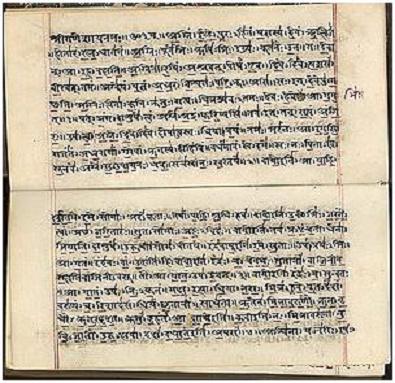
Rigvéda ( padapatha ) manuscript in Devanagari, early 19th century. After a scribal benediction ( "ŚrīgaṇéŚāyanamaḥ ;; Aum(3) ;;" ), the first line has the opening words of RV.1.1.1 (agniṃ ; iḷe ; puraḥ-hitaṃ ; yajñasya ; devaṃ ; ṛtvijaṃ ). The Védic accent is marked by underscores and vertical overscores in red.
MANDALAS
Mandala 1
comprises 191 hymns. Hymn 1.1 is addressed to Agni, and his name is the first word of the Rigvéda. The remaining hymns are mainly addressed to Agni and Indra, as well as Varuna, Mitra, the Ashvins, the Maruts, Usas, Surya, Rbhus, Rudra, Vayu, Brhaspati, Visnu, Heaven and Earth, and all the Gods.
Mandala 2
comprises 43 hymns, mainly to Agni and Indra. It is chiefly attributed to the Rishi gṛtsamada Śaunahotra.
Mandala 3
comprises 62 hymns, mainly to Agni and Indra and the Vishvedevas. The verse 3.62.10 has great importance in Hinduism as the Gayatri Mantra. Most hymns in this book are attributed to viŚvāmitra gāthinaḥ.
Mandala 4
comprises 58 hymns, mainly to Agni and Indra as well as the Rbhus, Ashvins, Brhaspati, Vayu, Usas, etc. Most hymns in this book are attributed to vāmadeva gautama.
Mandala 5
comprises 87 hymns, mainly to Agni and Indra, the Visvedevas ( "all the gods" ), the Maruts, the twin-deity Mitra-Varuna and the Asvins. 2 hymns each are dedicated to Ushas ( the dawn ) and to Savitr. Most hymns in this book are attributed to the atri clan.
Mandala 6
comprises 75 hymns, mainly to Agni and Indra, all the gods, Pusan, Ashvin, Usas, etc. Most hymns in this book are attributed to the bārhaspatya family of Angirasas.
Mandala 7
comprises 104 hymns, to Agni, Indra, the Visvadevas, the Maruts, Mitra-Varuna, the Asvins, Ushas, Indra-Varuna, Varuna, Vayu ( the wind ), two each to SarāŚvati ( ancient river / goddess of learning ) and Vishnu, and to others. Most hymns in this book are attributed to Vasiṣṭha maitravaruṇi.
Mandala 8
comprises 103 hymns to various gods. Hymns 8.49 to 8.59 are the apocryphal vālakhilya. Hymns 1–48 and 60–66 are attributed to the kāṇva clan, the rest to other ( Angirasa ) poets.
Mandala 9
comprises 114 hymns, entirely devoted to Soma Pavamana, the cleansing of the sacred potion of the Védic religion.
Mandala 10
comprises additional 191 hymns, frequently in later language, addressed to Agni, Indra and various other deities. It contains the Nadistuti Sūkta which is in praise of rivers and is important for the reconstruction of the geography of the Védic civilization and the Purusha Sūkta which has great significance in Hindu social tradition. It also contains the Nasadiya Sūkta ( 10.129 ), probably the most celebrated hymn in the west, which deals with creation. The marriage hymns ( 10.85 ) and the death hymns ( 10.10–18 ) still are of great importance in the performance of the corresponding Gṛhya rituals.
Dating and historical context
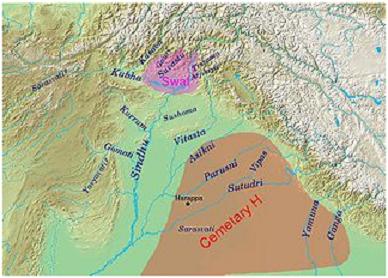
Geography of the Rigvéda, with river names; the extent of the Swat and Cemetery H cultures are also indicated.
The Rigvéda's core is accepted to date to the late Bronze Age, making it one of the few examples with an unbroken tradition. Its composition is usually dated to roughly between 1700–1100 BC. The Encyclopedia of Indo-European Culture ( s.v. Indo-Iranian languages, pg.306 ) gives 1500–1000. Being composed in an early Indo-Aryan language, the hymns must post-date the Indo-Iranian separation, dated to roughly 2000 BC. A reasonable date close to that of the composition of the core of the Rigvéda is that of the Indo-Aryan Mitanni documents of c. 1400 BC. Other evidence also points to a composition close to 1400 BC.
The Rigvéda is far more archaic than any other Indo-Aryan text. For this reason, it was in the center of attention of western scholarship from the times of Max Müller and Rudolf Roth onwards. The Rigvéda records an early stage of Védic religion. There are strong linguistic and cultural similarities with the early Iranian Avesta, deriving from the Proto-Indo-Iranian times, often associated with the early Andronovo culture of ca. 2000 BC.
The text in the following centuries underwent pronunciation revisions and standardization ( Saṃhitāpatha, padapatha ). This redaction would have been completed around the 6th century BC. Exact dates are not established, but they fall within the pre-Buddhist period ( 500, or rather 400 BC ).
Writing appears in India around the 3rd century BC in the form of the Brāhmi script, but texts of the length of the Rigvéda were likely not written down until much later, the oldest surviving Rigvédic manuscript dating to the 14th century. While written manuscripts were used for teaching in medieval times, they were written on birch bark or palm leaves, which decompose fairly quickly in the tropical climate, until the advent of the printing press from the 16th century. Some Rigvéda commentaries may date from the second half of the first millennium CE. The hymns were thus preserved by oral tradition for up to a millennium from the time of their composition until the redaction of the Rigvéda, and the entire Rigvéda was preserved in shakhas for another 2,500 years from the time of its redaction until the editio princeps by Rosen, Aufrecht and Max Müller.
After their composition, the texts were preserved and codified by an extensive body of Védic priesthood as the central philosophy of the Iron Age Védic civilization. The Brāhma Purana and the Vayu Purana name one Vidagdha as the author of the Padapatha. The Rk-pratishakhya names Sthavira Shakalya of the Aitareya āraṇyaka as its author.
The Rigvéda describes a mobile, semi-nomadic culture, with horse-drawn chariots, oxen-drawn wagons, and metal ( bronze ) weapons. The geography described is consistent with that of the Greater Punjab: Rivers flow north to south, the mountains are relatively remote but still visible and reachable ( Soma is a plant found in the high mountains, and it has to be purchased from tribal people ). Nevertheless, the hymns were certainly composed over a long period, with the oldest ( not preserved ) elements possibly reaching back to times close to the split of Proto-Indo-Iranian ( around 2000 BC ) Thus there was some debate over whether the boasts of the destruction of stone forts by the Védic Aryans and particularly by Indra refer to cities of the Indus Valley civilization or whether they rather hark back to clashes between the early Indo-Aryans with the BMAC in what is now northern Afghanistan and southern Turkmenistan ( separated from the upper Indus by the Hindu Kush mountain range, and some 400 km distant ).
While it is highly likely that the bulk of the Rigvédic hymns were composed in the Punjab, even if based on earlier poetic traditions, there is no mention of either tigers or rice in the Rigvéda ( as opposed to the later Védas ), suggesting that Védic culture only penetrated into the plains of India after its completion. Similarly, there is no mention of iron as the term ayas occurring in the Rigvéda refers to useful metal in general. The "black metal" ( kṛṣṇa ayas ) is first mentioned in the post-Rigvédic texts ( Atharvavéda etc. ). The Iron Age in northern India begins in the 10th century in the Greater Panjab. There is a widely accepted timeframe for the beginning codification of the Rigvéda by compiling the hymns very late in the Rigvédic or rather in the early post-Rigvédic period, including the arrangement of the individual hymns in ten books, coeval with and the composition of the younger véda Saṃhitās. This time coincides with the early Kuru kingdom, shifting the center of Védic culture east from the Punjab into what is now Uttar Pradesh. The fixing of the Saṃhitāpatha ( by keeping Sandhi ) intact and of the padapatha ( by dissolving Sandhi out of the earlier metrical text ), occurred during the later Brāhmaṃā period.
Some of the names of gods and goddesses found in the Rigvéda are found amongst other belief systems based on Proto-Indo-European religion, while words used share common roots with words from other Indo-European languages.
The horse ( āŚva ), cattle, sheep and goat play an important role in the Rigvéda. There are also references to the elephant ( Hastin, Varana ), camel ( Ustra, especially in Mandala 8 ), ass ( khara, rasabha ), buffalo ( Mahisa ), wolf, hyena, lion ( Simha ), mountain goat ( sarabha ) and to the gaur in the Rigvéda. The peafowl ( mayura ), the goose ( hamsa ) and the chakravaka ( Anas casarca ) are some birds mentioned in the Rigvéda.
Ancillary Texts
Rigvéda Brāhmaṇās
Of the Brāhmaṇās that were handed down in the schools of the Bahvṛcas ( i.e. "possessed of many verses" ), as the followers of the Rigvéda are called, 2 have come down to us, namely those of the Aitareyins and the Kaushitakins. The Aitareya-Brāhmaṃā and the Kaushitaki- ( or Sankhayana- ) Brāhmaṃā evidently have for their groundwork the same stock of traditional exegetic matter. They differ, however, considerably as regards both the arrangement of this matter and their stylistic handling of it, with the exception of the numerous legends common to both, in which the discrepancy is comparatively slight. There is also a certain amount of material peculiar to each of them.
The Kaushitaka is, upon the whole, far more concise in its style and more systematic in its arrangement features which would lead one to infer that it is probably the more modern work of the 2. It consists of thirty chapters ( adhyaya ); while the Aitareya has forty, divided into eight books ( or pentads, pancaka ), of five chapters each. The last 10 adhyayas of the latter work are, however, clearly a later addition though they must have already formed part of it at the time of Pāṇini ( ca. 5th c. BC ), if, as seems probable, one of his grammatical Sũtras, regulating the formation of the names of Brāhmaṇās, consisting of thirty and forty adhyayas, refers to these 2 works. In this last portion occurs the well-known legend ( also found in the Shankhayana-Sũtra, but not in the Kaushitaki-Brāhmaṃā ) of Shunahshepa, whom his father Ajigarta sells and offers to slay, the recital of which formed part of the inauguration of kings.
While the Aitareya deals almost exclusively with the Soma sacrifice, the Kaushitaka, in its first six chapters, treats of the several kinds of haviryajna, or offerings of rice, milk, ghee, &c., whereupon follows the Soma sacrifice in this way, that chapters 7-10 contain the practical ceremonial and 11–30 the recitations ( śāstra ) of the hotar. Sayana, in the introduction to his commentary on the work, ascribes the Aitareya to the sage Mahidasa Aitareya ( i.e. son of Itara ), also mentioned elsewhere as a philosopher; and it seems likely enough that this person arranged the Brāhmaṃā and founded the school of the Aitareyins. Regarding the authorship of the sister work we have no information, except that the opinion of the sage Kaushitaki is frequently referred to in it as authoritative, and generally in opposition to the Paingya-the Brāhmaṃā, it would seem, of a rival school, the Paingins. Probably, therefore, it is just what one of the manuscripts calls it-the Brāhmaṃā of Sankhayana ( composed ) in accordance with the views of Kaushitaki.
Rigvéda Āraṇyakas
Each of these 2 Brāhmaṇās is supplemented by a "forest book", or āraṇyaka. The Aitareyāraṇyaka is not a uniform production. It consists of five books ( āraṇyaka ), three of which, the first and the last two, are of a liturgical nature, treating of the ceremony called Mahāvrata, or great vow. The last of these books, composed in Sũtra form, is, however, doubtless of later origin, and is, indeed, ascribed by Hindu authorities either to Shaunaka or to āŚvalayana. The second and third books, on the other hand, are purely speculative, and are also styled the Bahvrca-Brāhmaṃā-Upanishad or Upaniṣads. Again, the last four chapters of the second book are usually singled out as the Aitareyopanishad, ascribed, like its Brāhmaṃā ( and the first book ), to Mahidasa Aitareya; and the third book is also referred to as the Saṃhitā-Upanishad or Upaniṣads. As regards the Kaushitaki-āraṇyaka, this work consists of 15 adhyayas, the first two ( treating of the Mahāvrata ceremony ) and the 7th and 8th of which correspond to the 1st, 5th, and 3rd books of the Aitareyāraṇyaka, respectively, whilst the four adhyayas usually inserted between them constitute the highly interesting Kaushitaki ( Brāhmaṃā- ) Upanishad or Upaniṣads, of which we possess 2 different recensions. The remaining portions ( 9-15 ) of the āraṇyaka treat of the vital airs, the internal Agnihotra, etc., ending with the vamsha, or succession of teachers.
Medieval Hindu scholarship
According to Hindu tradition, the Rigvédic hymns were collected by Paila under the guidance of Vyāsa, who formed the Rigvéda Saṃhitā as we know it. According to the Śatapatha Brāhmaṃā, the number of syllables in the Rigvéda is 432,000, equalling the number of muhurtas ( 1 day = 30 muhurtas ) in forty years. This statement stresses the underlying philosophy of the Védic books that there is a connection ( bandhu ) between the astronomical, the physiological, and the spiritual.
The authors of the Brāhmaṃā literature discussed and interpreted the Védic ritual. Yaska was an early commentator of the Rigvéda by discussing the meanings of difficult words. In the 14th century, Sāyana wrote an exhaustive commentary on it.
A number of other commentaries Bhāṣyas were written during the medieval period, including the commentaries by SkandāŚvamin ( pre-Sayana, roughly of the Gupta period ), Udgitha (pre-Sayana), Venkata-Madhava ( pre-Sayana, ca. 10th to 12th century ) and Mudgala ( after Sayana, an abbreviated version of Sayana's commentary ).
In contemporary Hinduism
Hindu revivalism
Since the 19th and 20th centuries, some reformers like Swami Dayananda SarāŚvati, founder of the Arya Samaj and Sri Aurobindo have attempted to re-interpret the Védas to conform to modern and established moral and spiritual norms. Dayananda considered the Védas ( which he defined to include only the Saṃhitās ) to be source of truth, totally free of error and containing the seeds of all valid knowledge. Contrary to common understanding, he was adamant that Védas were monotheistic and that they did not sanction idol worship. Starting 1877, he intended to publish commentary on the four Védas but completed work on only the Yajurveda, and a partial commentary on the Rigvéda. Dayananda's work is not highly regarded by Védic scholars and Indologist Louis Renou, among others, dismissed it as, "a vigorous ( and from our point of view, extremely aberrant ) interpretation in the social and political sense."
Dayananda and Aurobindo moved the védantic perception of the Rigvéda from the original ritualistic content to a more symbolic or mystical interpretation. For example, instances of animal sacrifice were not seen by them as literal slaughtering, but as transcendental processes.
"Indigenous Aryans" debate
Questions surrounding the Rigvédic SarāŚvati River and the Nadistuti Sūkta in particular have become tied to an ideological debate on the Indo-Aryan migration ( termed "Aryan Invasion Theory" ) versus the claim that Védic culture, together with Védic Sanskrit, originated in the Indus Valley Civilization ( termed "Out of India theory" ), a topic of great significance in Hindu nationalism, addressed for example by K. D. Sethna and in Shrikant G. Talageri's The Rigvéda: A Historical Analysis. Subhash Kak ( 1994 ) claimed that there is an "astronomical code" in the Organisation of the hymns. Bal Gangadhar Tilak, also based on astronomical alignments in the Rigvéda, in his "The Orion" ( 1893 ) had claimed presence of the Rigvédic culture in India in the 4th millennium BC, and in his The Arctic Home in the Védas ( 1903 ) even argued that the Aryans originated near the North Pole and came south during the ice age.
Debate on alternative suggestions on the date of the Rigvéda, typically much earlier dates, are mostly taking place outside of scholarly literature. Some writers out of the mainstream claim to trace astronomical references in the Rigvéda, dating it to as early as 4000 BC, a date well within the Indian Neolithic. Publications to this effect have increased during the late 1990s to early 2000s in the context of historical revisionism in Hindu nationalism, notably in books published by Voice of India.
Translations
The first published translation of any portion of the Rigvéda in any Western language was into Latin, by Friedrich August Rosen ( Rigvedae specimen, London 1830 ). Predating Müller's editio princeps of the text, Rosen was working from manuscripts brought back from India by Colebrooke.
H. H. Wilson was the first to make a complete translation of the Rigvéda into English, published in six volumes during the period 1850–88. Wilson's version was based on the commentary of Sāyaṇa. In 1977, Wilson's edition was enlarged by Nag Sharan Singh ( Nag Publishers, Delhi, 2nd ed. 1990 ).
In 1889, Ralph T.H. Griffith published his translation as The Hymns of the Rigvéda, published in London ( 1889 ).
A German translation was published by Karl Friedrich Geldner, Der Rigvéda: aus dem Sanskrit ins Deutsche Übersetzt, Harvard Oriental Studies, vols. 33–37 ( Cambridge, Massachusetts: 1951-7 ).
Geldner's translation was the philologically best-informed to date, and a Russian translation based on Geldner's[citation needed] by Tatyana Elizarenkova was published by Nauka 1989–1999
A 2001 revised edition of Wilson's translation was published by Ravi Prakash Arya and K. L. Joshi. The revised edition updates Wilson's translation by replacing obsolete English forms with more modern equivalents, giving the English translation along with the original Sanskrit text in Devanagari script, along with a critical apparatus.
In 2004 the United States' National Endowment for the Humanities funded Joel Brereton and Stephanie W. Jamison as project directors for a new original translation to be issued by Oxford University Press.
Numerous partial translations exist into various languages. Notable examples include :
| Data Arrangement, Technical Arrangement & Graphics |
|---|
| • Guruji Murugan Chillayah - World Yoga Association |
| References ( Rigvéda ) |
| Notes |
| • derived from the root ṛc "to praise", cf. Dhātupātha 28.19. Monier-Williams translates "a véda of Praise or Hymn-véda" |
| • There is some confusion with the term "véda", which is traditionally applied to the texts associated with the Saṃhitā proper, such as Brāhmaṇās or Upanishad or Upaniṣads. In English usage, the term Rigvéda is usually used to refer to the Rigvéda Saṃhitā alone, and texts like the Aitareya-Brāhmaṃā are not considered "part of the Rigvéda" but rather "associated with the Rigvéda" in the tradition of a certain shakha. |
| • Werner, Karel (1994). A Popular Dictionary of Hinduism. Curzon Press. ISBN 0700710493. |
| • Oberlies (1998:155) gives an estimate of 1100 BC for the youngest hymns in book 10. Estimates for a terminus post quem of the earliest hymns are more uncertain. Oberlies (p. 158) based on 'cumulative evidence' sets wide range of 1700–1100 |
| • H. Oldenberg, Prolegomena,1888, Engl. transl. New Delhi: Motilal 2004 |
| • K. Meenakshi (2002). "Making of Pāṇini". In George Cardona, Madhav Deshpande, Peter Edwin Hook. Indian Linguistic Studies: Festschrift in Honor of George Cardona. Motilal Banarsidass. pp. 235. ISBN 8120818857. |
| • The oldest manuscript in the Pune collection dates to the 15th century. The Benares Sanskrit University has a Rigvéda manuscript of the 14th century. Earlier manuscripts are extremely rare; the oldest known manuscript preserving a Védic text was written in the 11th century in Nepal (catalogued by the Nepal-German Manuscript Preservation Project, Hamburg. |
| • B. van Nooten and G. Holland, Rigvéda. A metrically restored text. Cambridge: Harvard Oriental Series 1994 |
| • Michael Witzel says that "The RV has been transmitted in one recension (the Śākhā of Śākalya) while others (such as the Bāṣkala text) have been lost or are only rumored about so far." Michael Witzel, p. 69, "Védas and Upaniṣads", in: The Blackwell Companion to Hinduism, Gavin Flood (ed.), Blackwell Publishing Ltd., 2005. |
| • Maurice Winternitz (History of Sanskrit Literature, Revised English Translation Edition, 1926, vol. 1, p. 57) says that "Of the different recensions of this Saṃhitā, which once existed, only a single one has come down to us." He adds in a note (p. 57, note 1) that this refers to the "recension of the Śākalaka-School." |
| • Sures Chandra Banerji (A Companion To Sanskrit Literature, Second Edition, 1989, Motilal Banarsidass, Delhi, pp. 300–301) says that "Of the 21 recensions of this véda, that were known at one time, we have got only two, viz. Śākala and Vāṣkala." |
| • Maurice Winternitz (History of Sanskrit Literature, Revised English Translation Edition, 1926, vol. 1, p. 283. |
| • Mantras of "khila" hymns were called khailika and not ṛcas (Khila meant distinct "part" of Rgvéda separate from regular hymns; all regular hymns make up the akhila or "the whole" recognised in a Śākhā, although khila hymns have sanctified roles in rituals from ancient times). |
| • Hermann Grassmann had numbered the hymns 1 through to 1028, putting the vālakhilya at the end. Griffith's translation has these 11 at the end of the 8th mandala, after 8.92 in the regular series. |
| • cf. Preface to Khila section by C.G.Kāshikar in Volume-5 of Pune Edition of RV (in references). |
| • These Khilani hymns have also been found in a manuscript of the Śākala recension of the Kashmir Rigvéda (and are included in the Poone edition). |
| • equalling 40 times 10,800, the number of bricks used for the uttaravedi: the number is motivated numerologically rather than based on an actual syllable count. |
| • In a few cases, more than one rishi is given, signifying lack of certainty. |
| • Talageri (2000), p.33 |
| • "Rigvéda". UNESCO Memory of the World Programme. |
| • hinduism.about.com |
| • cf. Editorial notes in various volumes of Pune Edition, see references. |
| • Oberlies (1998:155) gives an estimate of 1100 BC for the youngest hymns in book 10. Estimates for a terminus post quem of the earliest hymns are far more uncertain. Oberlies (p. 158) based on 'cumulative evidence' sets wide range of 1700–1100 |
| • Philological estimates tend to date the bulk of the text to the second half of the second millennium. Compare Max Müller's statement "the hymns of the Rigvéda are said to date from 1500 BC" ('véda and Védāṅta', 7th lecture in India: What Can It Teach Us: A Course of Lectures Delivered Before the University of Cambridge, World Treasures of the Library of Congress Beginnings by Irene U. Chambers, Michael S. Roth. |
| • Mallory, J. P.; Adams, Douglas Q. (1997). "Indo-Iranian Languages". Encyclopedia of Indo-European Culture. Fitzroy Dearborn. |
| • "As a possible date ad quem for the RV one usually adduces the Hittite-Mitanni agreement of the middle of the 14th cent. B.C. which mentions four of the major RgVédic gods: mitra, varuNa, indra and the nAsatya azvin)" M. Witzel, Early Sanskritization – Origin and development of the Kuru state. |
| • The Védic People: Their History and Geography, Rajesh Kochar, 2000, Orient Longman, ISBN 8125013849 |
| • Rigvéda and River SarāŚvati: class.uidaho.edu |
| • Oldenberg 1894 (tr. Shrotri), p.14 "The Védic diction has a great number of favourite expressions which are common with the Avestic, though not with later Indian diction. In addition, there is a close resemblance between them in metrical form, in fact, in their overall poetic character. If it is noticed that whole Avesta verses can be easily translated into the Védic alone by virtue of comparative phonetics, then this may often give, not only correct Védic words and phrases, but also the verses, out of which the soul of Védic poetry appears to speak." |
| • Mallory 1989 p.36 "Probably the least-contested observation concerning the various Indo-European dialects is that those languages grouped together as Indic and Iranian show such remarkable similarities with one another that we can confidently posit a period of Indo-Iranian unity..." |
| • Bryant 2001:130–131 "The oldest part of the Avesta... is linguistically and culturally very close to the material preserved in the Rgvéda... There seems to be economic and religious interaction and perhaps rivalry operating here, which justifies scholars in placing the Védic and Avestan worlds in close chronological, geographical and cultural proximity to each other not far removed from a joint Indo-Iranian period." |
| • Mallory 1989 "The identification of the Andronovo culure as Indo-Iranian is commonly accepted by scholars." |
| • Oldenberg (p. 379) places it near the end of the Brāhmaṃā period, seeing that the older Brāhmaṇās still contain pre-normalized Rigvédic citations. The Brāhmaṃā period is later than the composition of the Saṃhitās of the other Védas, stretching for about the 10th to 6th centuries. This would mean that the redaction of the texts as preserved was completed in roughly the 6th century BC. The EIEC (p. 306) gives a 7th century date. |
| • The Shatapatha Brāhmaṃā refers to a Vidagdha Shakalya without discussing anything related to the Padapatha. |
| • Jha 1992[page needed] |
| • minority opinions name dates as early as the 4th millennium BC; "The Aryan Non-Invasionist Model" by Koenraad Elst |
| • There is however mention of ApUpa, Puro-das and Odana in the Rigvéda, terms that, at least in later texts, refer to rice dishes, see Talageri (2000) |
| • The term "ayas" (=metal) occurs in the Rigvéda, usually translated as "bronze", although Chakrabarti, D.K. The Early Use of Iron in India (1992) Oxford University Press argues that it may refer to any metal. If ayas refers to iron, the Rigvéda must date to the late 2nd millennium at the earliest. |
| • among others, Macdonell and Keith, and Talageri 2000, Lal 2005 |
| • Edited, with an English translation, by M. Haug (2 vols., Bombay, 1863). An edition in Roman transliteration, with extracts from the commentary, has been published by Th. Aufrecht (Bonn, 1879). |
| • edited in 8 volumes by Vishva Bandhu, 1963–1966. |
| • Salmond, Noel A. (2004). "Dayananda SarāŚvati". Hindu iconoclasts: Rammohun Roy, Dayananda SarāŚvati and nineteenth-century polemics against idolatry. Wilfrid Laurier University Press. pp. 65–91. ISBN 0-88920-419-5. |
| • Llewellwyn, John (1994). "From interpretation to reform: Dayanand's reading of the Védas". In Patton, Laurie L.. Authority, anxiety, and canon: essays in Védic interpretation. Albany, N.Y: State University of New York Press. pp. 235–252. ISBN 0-7914-1937-1. |
| • Renou, Louis (1965). The destiny of the véda in India. Motilal Banarsidas. p. 4. |
| • summarized by Klaus Klostermaier in a 1998 presentation |
| • e.g. Michael Witzel, The Pleiades and the Bears viewed from inside the Védic texts, EVJS Vol. 5 (1999), issue 2 (December) [1]; Elst, Koenraad (1999). Update on the Aryan Invasion Debate. Aditya Prakashan. ISBN 81-86471-77-4.; Bryant, Edwin and Laurie L. Patton (2005) The Indo-Aryan Controversy, Routledge/Curzon. |
| • they reached a peak when the academic Journal of Indo-European Studies waived peer-review in a 2002 issue in order to give a platform to the views of N. Kazanas, suggests a date as early as 3100 BC. The journal's editor J. P. Mallory described this exceptional issue as motivated by a "sense of fair play". The debate consisted of an article by Kazanas, nine highly critical reviews by referees published in reply and a "final response" by Kazanas (Journal of Indo-European Studies 30, 2002. Journal of Indo-European Studies 31, 2003) |
| • Wilson, H. H. Ṛig-véda-Sanhitā: A Collection of Ancient Hindu Hymns. 6 vols. (London, 1850–88); repring: Cosmo Publications (1977) |
| • reprinted Delhi 1973, reprinted by Munshiram Manoharlal Publishers: 1999. Complete revised and enlarged edition. 2-volume set. ISBN 8121500419 |
| • reprint: Harvard Department of Sanskrit and Indian Studies Harvard (University Press) (2003) ISBN 0-674-01226-7 |
| • extended from a partial translation Rigvéda: Izbrannye Gimny, published in 1972. |
| • Ravi Prakash Arya and K. L. Joshi. ṛgvéda Saṃhitā: Sanskrit Text, English Translation, Notes & Index of Verses. (Parimal Publications: Delhi, 2001) ISBN 81-7110-138-7 (Set of four volumes). Parimal Sanskrit Series No. 45; 2003 reprint: 81-7020-070-9 |
| • neh.gov, retrieved 22 March 2007. |
| • Joel Brereton and Stephanie W. Jamison. The Rigvéda: Translation and Explanatory Notes. (Oxford University Press) ISBN 0195179188 |
| • See Appendix 3, O'Flaherty, Wendy Doniger. The Rigvéda. (Penguin Books: 1981) ISBN 0-140-44989-2 |
| Bibliography |
| Editions |
| • editio princeps: Friedrich Max Müller, The Hymns of the Rigvéda, with Sayana's commentary, London, 1849–75, 6 vols., 2nd ed. 4 vols., Oxford, 1890–92. |
| • Theodor Aufrecht, 2nd ed., Bonn, 1877. |
| • Sontakke, N. S., ed (1933–46,Reprint 1972–1983.). Rgvéda-Saṃhitā: Śrimat-Sāyanāchārya virachita-Bhāṣya-sametā (First ed.). Pune: Vaidika SamŚodhāna Maṇḍala. The Editorial Board for the First Edition included N. S. Sontakke (Managing Editor), V. K. Rājvade, M. M. VāsudevaŚāstri, and T. S. VaradarājaŚarmā. |
| • B. van Nooten und G. Holland, Rigvéda, a metrically restored text, Department of Sanskrit and Indian Studies, Harvard University, Harvard University Press, Cambridge, Massachusetts and London, England, 1994. |
| • Rgvéda-Saṃhitā, Text in Devanagari, English translation Notes and indices by H. H. Wilson, Ed. W.F. Webster, originally in 1888, Published Nag Publishers 1990, 11A/U.A. Jawaharnagar,Delhi-7. |
| Commentary |
| • Sayana (14th century) |
| o ed. Müller 1849–75 (German translation); |
| o ed. Müller (original commentary of Sāyana in Sanskrit based on 24 manuscripts). |
| o ed. Sontakke et al., published by Vaidika Samsodhāna Mandala, Pune (2nd ed. 1972) in 5 volumes. |
| • Rgvéda-Saṃhitā Srimat-sāyanāchārya virachita-Bhāṣya-sametā, ed. by Sontakke et al., published by Vaidika SamŚodhāna Mandala,Pune-9,1972 ,in 5 volumes (It is original commentary of Sāyana in Sanskrit based on over 60 manuscripts). |
| • Sri Aurobindo: Hymns to the Mystic Fire (Commentary on the Rigvéda), Lotus Press, Twin Lakes, Wisconsin ISBN 0-914955-22-5 |
| Philology |
| • Vashishtha Narayan Jha, A Linguistic Analysis of the Rgvéda-Padapatha Sri Satguru Publications, Delhi (1992). |
| • Bjorn Merker, Rigvéda Riddles In Nomad Perspective, Mongolian Studies, Journal of the Mongolian Society XI, 1988. |
| • Thomas Oberlies, Die Religion des Rgvéda, Wien 1998. |
| • Oldenberg, Hermann: Hymnen des Rigvéda. 1. Teil: Metrische und textgeschichtliche Prolegomena. Berlin 1888; Wiesbaden 1982. |
| • -Die Religion des véda. Berlin 1894; Stuttgart 1917; Stuttgart 1927; Darmstadt 1977 |
| • -Védic Hymns, The Sacred Books of the East vo, l. 46 ed. Friedrich Max Müller, Oxford 1897 |
| • Adolf Kaegi, The Rigvéda: The Oldest Literature of the Indians (trans. R. Arrowsmith), Boston,, Ginn and Co. (1886), 2004 reprint: ISBN 9781417982059. |
| Historical |
| • Bryant, Edwin (2001). The Quest for the Origins of Védic Culture: The Indo-Aryan Migration Debate. Oxford: Oxford University Press. ISBN 0195137779 |
| • Lal, B.B. 2005. The Homeland of the Aryans. Evidence of Rigvédic Flora and Fauna & Archaeology, New Delhi, Aryan Books International. |
| • Talageri, Shrikant: The Rigvéda: A Historical Analysis, 2000. ISBN 81-7742-010-0 Archaeoastronomy |
| • Tilak, Bal Gangadhar: The Orion, 1893 |

Notes
READ MORE
English pronunciation : véda / Vētā / Vētam / Vēdham āyvukaḷ / ñāṉam Vaḷarcci Peṟa / Rikvēdaṁ / Rik vētam / Yajūr vētam / Sāma vētam / Atarvaṉa vētam /
Sanskrit संस्कृतम् : वेद /
Tamil தமிழ் : வேதா / வேதம் ஆய்வுகள் / ஞானம் வளர்ச்சி பெற / ரிக் வேதம் / யஜூர் வேதம் / சாம வேதம் / அதர்வன வேதம்
Bahasa Melayu : Rigvéda / Yajurveda / Sāmavéda / Atharvavéda /
Malayalam : not_available /
Telugu : రుగ్వేదం ( Rugvēdaṁ ) / యజుర్వేదం ( Yajurvēdaṁ) / సామవేదం ( Sāmavēdaṁ ) / అధర్వ వేదం ( Adharva vēdaṁ ) /
Français : not_available
INTRODUCTION
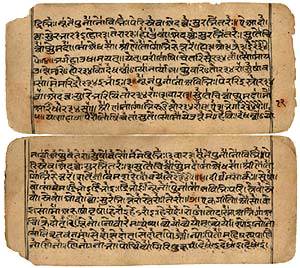
The Sāmavéda ( Sanskrit : सामवेदः, Sāmavéda, from sāman "melody" + véda "knowledge" ), is second ( in the usual order ) of the four Védas, the ancient core Hindu scriptures. Its earliest parts are believed to date from 1700 BC ( since all of its verses are from the Rigvéda ) and it ranks next in sanctity and liturgical importance to the Rigvéda. It consists of a collection ( Saṃhitā ) of hymns, portions of hymns, and detached verses, all but 75 taken from the Sakala Sakha of the Rigvéda, the other 75 belong to the Bashkala Sakha, to be sung, using specifically indicated melodies called Samagana, by Udgatar priests at sacrifices in which the juice of the Soma plant, clarified and mixed with milk and other ingredients, is offered in libation to various deities.
The verses have been transposed and re-arranged, without reference to their original order, to suit the rituals in which they were to be employed. There are frequent variations from the text of the Rigvéda that are in some cases glosses but in others offer an older pronunciation than that of the Rigvéda ( such as [ai] for common [e] ). When sung the verses are further altered by prolongation, repetition and insertion of stray syllables ( stobha ), as well as various modulations, rests and other modifications prescribed in the song-books ( Ganas ). Sāmavéda's Upavéda ( technical manual ) is Gāndharvavéda that deals not only with the topics of music but also of dance and theatre.
The Sāmavéda Saṃhitā ( from sāman, the term for a melody applied to metrical hymn or song of praise ) consists of 1549 stanzas, taken almost entirely ( except for 78 stanzas ) from the Rigvéda. Like the Rigvédic stanzas in the Yajurveda, the Samans have been changed and adapted for use in singing. Some of the Rigvédic verses are repeated more than once. Including repetitions, there are a total of 1875 verses numbered in the Sāmavéda recension translated by Griffith. 2 major recensions remain today, the Kauthuma / Ranayaniya and the Jaiminiya. Its purpose was liturgical, as the repertoire of the udgātṛ or "singer" priests who took part in the sacrifice.
Recensions
R. T. H. Griffith says that there are 3 recensions of the text of the Sāmavéda Saṃhitā:
While the Kauthuma recension has been published ( Saṃhitā, Brāhmaṃā, Shrauta (Śrauta)Sũtra and ancillary Sũtras, mainly by the late B.R. Sharma ), parts of the Jaiminiya tradition remain unpublished. There is an edition of the first part of the Saṃhitā by W. Caland and of the Brāhmaṃā by Raghu Vira and Lokesh Chandra, as well as the neglected Upanishad or Upaniṣads, but only parts of the Shrauta (Śrauta)Sũtra. The song books remain unpublished and the tradition is rapidly fading. However, an edition is now being prepared by some well-known Sāmavéda specialists.
| Data Arrangement, Technical Arrangement & Graphics |
|---|
| • Guruji Murugan Chillayah - World Yoga Association |
| References ( Sāmavéda ) |
| • A. Parpola. The literature & study of the Jaiminīya Sāmavéda. Studia Orientalia XLIII:6. Helsinki 1973 |
| • A. Parpola. The decipherment of the SamaVédic notation of the Jaiminīyas. Finnish Oriental Society 1988 |
| • Griffith (Benares, 1893) english translation |
| • Griffith, Ralph T. H. The Sāmavéda Saṃhitā. Text, Translation, Commentary & Notes in English, first published 1893 |
| • Griffith, Ralph T. H. The Sāmavéda Saṃhitā. p. vi. op. cit. |
| • H. Oertel. The Jaiminīya or Talavakāra Upaniṣad Brāhmaṃā. Text, translation, and notes. |
| • Mridul Kirti translation in Hindi called "Samvéda Ka Hindi Padyanuvad" |
| • Nag Sharan Singh and Surendra Pratap, 1991 -Revised edition with text in Devanagari (full metrical marks for chanting) |
| • Raghu Vira and Lokesh Chandra. 1954. Jaiminīya-Brāhmaṃā of the Sāmavéda. (SarāŚvati-Vihara Series 31), Delhi 1986 |
| • Satyavrata Samashrami in Bibl. Ind. (Calcutta, 1873) edited and published |
| • Theodor Benfey (Leipzig, 1848, with a German translation) edited and published |
| • W. Caland, Die Jaiminīya-Saṃhitā mit einer Einleitung über die Sāmavéda-literatur. Breslau 1907 |

Notes
READ MORE
English pronunciation : véda / Vētā / Vētam / Vēdham āyvukaḷ / ñāṉam Vaḷarcci Peṟa / Rikvēdaṁ / Rik vētam / Yajūr vētam / Sāma vētam / Atarvaṉa vētam /
Sanskrit संस्कृतम् : वेद /
Tamil தமிழ் : வேதா / வேதம் ஆய்வுகள் / ஞானம் வளர்ச்சி பெற / ரிக் வேதம் / யஜூர் வேதம் / சாம வேதம் / அதர்வன வேதம்
Bahasa Melayu : Rigvéda / Yajurveda / Sāmavéda / Atharvavéda /
Malayalam : not_available /
Telugu : రుగ్వేదం ( Rugvēdaṁ ) / యజుర్వేదం ( Yajurvēdaṁ) / సామవేదం ( Sāmavēdaṁ ) / అధర్వ వేదం ( Adharva vēdaṁ ) /
Français : not_available
INTRODUCTION

Above Image : vAjasaneyi Yajurveda
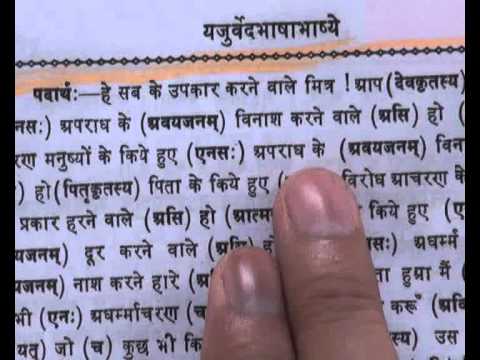
The Yajurveda, ( a tatpurusha compound of "sacrificial formula', + véda ) is the third of the 4 canonical texts of Hinduism, the Védas. By some, it is estimated to have been composed between 1400 and 1000 BC, the Yajurveda 'Saṃhitā', or 'compilation', contains the liturgy ( mantras ) needed to perform the sacrifices of the religion of the Védic period, and the added Brāhmaṃā and Shrauta (Śrauta)Sũtra add information on the interpretation and on the details of their performance.
The Yajurveda Saṃhitā consists of archaic prose mantras and also in part of verses borrowed and adapted from the Rigvéda. Its purpose was practical, in that each mantra must accompany an action in sacrifice but, unlike the Sāmavéda, it was compiled to apply to all sacrificial rites, not merely the Somayajna. There are two major groups of recensions of this véda, known as the "Black" ( Krishna ) and "White" ( Shukla ) Yajurveda ( Krishna and Shukla Yajurveda respectively ). While White Yajurveda separates the Saṃhitā from its Brāhmaṃā ( the Shatapatha Brāhmaṃā ), the e Black Yajurveda intersperses the Saṃhitā with Brāhmaṃā commentary. Of the Black Yajurveda 4 major recensions survive ( Maitrayani, Katha, Kapisthala-Katha, Taittiriya ).
Recensions
There are 2 primary versions or Saṃhitās of the Yajurveda: Shukla ( white ) and Krishna ( black ). Both contain the verses necessary for rituals, but the Krishna Yajurveda includes the Brāhmaṃā prose discussions mixed within the Saṃhitā, while the Shukla Yajurveda has separately a Brāhmaṃā text, the Shatapatha Brāhmaṃā.
Shukla Yajurveda
The Shukla Yajurveda is represented by the Vajasaneyi Saṃhitā. The name Vajasaneyi is derived from Vajasaneya, patronymic of sage Yajnavalkya, an authority and according to tradition, founder of the Vajasaneyi branch. The Vajasaneyi Saṃhitā has forty chapters or adhyayas, containing the formulas used with the following rituals :
1.-2.: New and Full Moon sacrifices
3.: Agnihotra
4.-8.: Somayajna
9.-10.: Vajapeya and Rajasuya, 2 modifications of the Soma sacrifice
11.-18.: construction of altars and hearths, especially the Agnicayana
19.-21.: Sautramani, a ritual originally counteracting the effects of excessive Soma-drinking
22.-25.: āŚvamedha
26.-29.: supplementary formulas for various rituals
30.-31.: Purushamedha
32.-34.: Sarvāmedha
35.: Pitriyajna
36.-39.: Pravargya
40.: the final adhyaya is the famous Isha Upanishad or Upaniṣads
There are 2 ( nearly identical ) shakhas or recensions of the Vajasaneyi Saṃhitā ( VS ) :
Both the Kanva and Madhyandina Saṃhitās have been transmitted with the common anudatta, udatta, and svarita accentuation ( unlike the two-tone bhasika accent of the Shatapatha Brāhmaṃā ).
The Madhyandina Saṃhitā is popular in all over North India, Gujarat, parts of Mahārashtra ( north of Nashik ) and thus commands a numerous following. The Kanva Shakha is popular in parts of Mahārashtra ( south of Nashik ), Orissa, Karnataka, Andhra Pradesh and parts of Tamil Nadu. SureshvarAchãrya, one of the four main disciples of Jagadguru Adi Shankara, is said to have followed the Kanva shakha. The Guru himself followed the Taittiriya Shakha with the Apastamba KalpaSũtra.
The Védic rituals of the Ranganathaswamy Temple at Srirangam, the second biggest temple in India, are performed according to the Kanva shakha. The Jayakhya Saṃhitā of Pañcaratra says its followers are from Kanva shakha.
The extant Āraṇyakas, Upanishad or Upaniṣads, Shrauta (Śrauta)Sũtras, GṛhyaSũtras and Pratishakhyas are same for both Madhayndina and Kanva shakhas. The Shukla Yajurveda has two Upanishad or Upaniṣads associated with it : the Ishavasya, as the last part of te Saṃhitā, and the Brihadāraṇyaka Upanishad or Upaniṣads, the last part of the Shatapatha Brāhmaṃā. The Brihadāraṇyaka Upanishad or Upaniṣads is the most voluminous of all Upanishad or Upaniṣads. Other texts are Kātyāyana Shrauta (Śrauta)Sũtra, Paraskara GṛhyaSũtra and Shukla Yajurveda Pratishakhya. The Shukla Yajurvedins ( followers of the Shukla Yajurveda ) are sometimes called the Kātyāyanas.
Krishna Yajurveda
There are 4 recensions of the Krishna Yajurveda :
• Taittirīya Saṃhitā ( TS ) originally of Panchala
• Maitrayani Saṃhitā ( MS ) originally of the area south of Kurukshetra
• Caraka-Kaṭha Saṃhitā ( KS ) originally of Madra and Kurukshetra
• Kapiṣṭhala-Kaṭha Saṃhitā ( KapS ) of the southern Punjab and Bahika
Each of the recensions has or had a Brāhmaṃā associated with it, and most of them also have associated Shrauta (Śrauta)Sũtras, GṛhyaSũtras, Āraṇyakas, Upanishad or Upaniṣads and Pratishakhyas.
The Taittiriya Shakha
The best known and best preserved of these recensions is the Taittirīya Saṃhitā, named after Tittiri, a pupil of Yaska and an authority according to Panini., Tittiri in Sanskrit means partridge, and according to a legend, Yajnavalkya had quickly grasped a portion of the Yajurveda, but due to his arrogance, he was asked to eject out the portion by his teacher, who was incensed by his attitude. By his learned knowledge, he was able to retch out what he had studied. This regurgitated portion was swallowed by a covey of partridges and known as the TS.
The Taittirīya Saṃhitā consists 7 books or Kāṇḍas, subdivided in chapters or prapathakas, further subdivided into individual sections ( anuvakas ). Some individual hymns in this Saṃhitā have gained particular importance in Hinduism; e.g. TS 4.5 and TS 4.7 constitute the Rudram Chamakam, while 1.8.6.i is the Shaivaite Tryambakam mantra. The beejas bhūr bhuvaḥ suvaḥ prefixed to the ( Rigvédic ) Savitur Gayatri mantra are also from the Yajurveda. The Taittiriya recension of the Black Yajurveda is the shakha now most prevalent in southern India. Among the followers of this Shakha, the Apastamba Sũtras are the common. The Taittiriya Shakha consists of Taittiriya Saṃhitā ( having 7 Kāṇḍas ), Taittiriya Brāhmaṃā ( having 3 Kāṇḍas ), Taittiriya āraṇyaka ( having 7 prashnas ) ( See āraṇyaka Literature ), Taittiriya Upanishad or Upaniṣads ( having 3 prashnas or vallis – Shiksha valli, Ananda valli and Bhrigu valli ) and the Mahānarayana Upanishad or Upaniṣads. The Taittiriya Upanishad or Upaniṣads and Mahānarayana Upanishad or Upaniṣads are considered to be the seventh, eighth, ninth and tenth prashnas of the āraṇyaka. The words prapathaka and Kāṇḍa ( meaning sections ) are interchangeably used in Védic literature. Prashna and valli refer to sections of the āraṇyaka.
7 schools of Shrauta
7 schools of Shrauta (Śrauta)Sũtras and GṛhyaSũtras are related to the Taittiriya Shakha. These are :
1. Apastamba
2. Agniveshya
3. Baudhayana
4. Hiraṇyakeshi
5. Vaikhanasa
6. Bharadvaja
7. Vadhula
There is another short tract apart from the above, commonly known as Ekagni Kāṇḍa, which mainly consists of mantra-s used in the marriage and other rituals.
The Maitrayani Shakha
Propounded by Sage Maitreya, the followers of this shakha reside in northern parts of Mahārastra and Gujarat. The Maitrayani Saṃhitā differs to some extent in content from the Taittiriyas, as well as in some different arrangement of chapters. Its Brāhmaṃā portions are mixed with the Mantra sections, like in the Taittiriya Saṃhitā. The well known Maitrayaniya Upanishad or Upaniṣads and Maitrayaniya āraṇyaka belong to this shakha.
Two schools of the Shrauta (Śrauta)Sũtras, GṛhyaSũtras and Shulba Sũtras are related to this shakha :
1. Manava
2. Vārāha
Other Shakhas
The Caraka-Katha and Kapisthala shakhas are available with their texts. Previously Brāhmiṇs of Kashmir and Punjab were the followers of these shakhas; nowadays only the Kashmiris follow the Gṛhya rituals of the Katha Shakha.
The Kāṭhaka Saṃhitā or the Caraka-Kaṭha Saṃhitā, according to tradition was compiled by Katha, a disciple of Vaisampayana. Its contents are less complete comparing to the Taittiriya Saṃhitā. It comprises 40 chapters, apparently originally arranged into 5 books. The Kapiṣṭhala Saṃhitā or the Kapiṣṭhala-Kaṭha Saṃhitā, named after sage Kapisthala is extant only in some large fragments. This text is practically a variant of the Kāṭhaka Saṃhitā.
The well known Laugakshi GrihyaSũtra ( or Kathaka Gṛhya Sũtra ) is associated with the Kathaka Sakha and is used, in Paddhati form, by Kashmiri Brāhmiṇs.
| Data Arrangement, Technical Arrangement & Graphics |
|---|
| • Guruji Murugan Chillayah - World Yoga Association |
| References ( Yajurveda ) |
| • Dowson, John (1984) [1879]. A Classical Dictionary of Hindu Mythology and Religion, Geography, History. pg.319 |
| • Gonda, Jan1975. A History of Indian Literature: véda and Upanishad or Upaniṣads. Vol.I. Wiesbaden: Otto Harrassowitz. pp. 326–7 |
| • Ralph Thomas Hotchkin Griffith, The Texts of the White Yajurveda. Translated with a Popular Commentary (1899) |
| • Devi Chand, The Yajurveda. Sanskrit text with English translation. Third thoroughly revised and enlarged edition (1980) |
| • The Sanhitâ of the Black Yajurveda with the Commentary of Mâdhava ‘Achârya, Calcutta (10 volumes, 1854–1899) |
| • Kumar, Pushpendra, Taittiriya Brāhmaṃām (Krsnam Yajurveda), 3 vols., Delhi (1998) |

Notes
READ MORE
English pronunciation : véda / Vētā / Vētam / Vēdham āyvukaḷ / ñāṉam Vaḷarcci Peṟa / Rikvēdaṁ / Rik vētam / Yajūr vētam / Sāma vētam / Atarvaṉa vētam /
Sanskrit संस्कृतम् : वेद /
Tamil தமிழ் : வேதா / வேதம் ஆய்வுகள் / ஞானம் வளர்ச்சி பெற / ரிக் வேதம் / யஜூர் வேதம் / சாம வேதம் / அதர்வன வேதம்
Bahasa Melayu : Rigvéda / Yajurveda / Sāmavéda / Atharvavéda /
Malayalam : not_available /
Telugu : రుగ్వేదం ( Rugvēdaṁ ) / యజుర్వేదం ( Yajurvēdaṁ) / సామవేదం ( Sāmavēdaṁ ) / అధర్వ వేదం ( Adharva vēdaṁ ) /
Français : not_available
Introduction
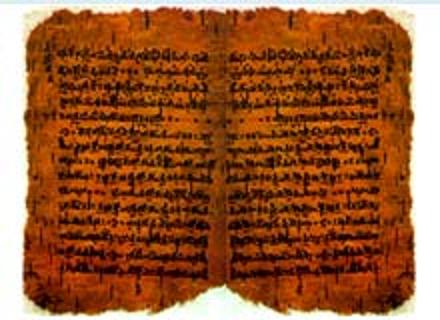
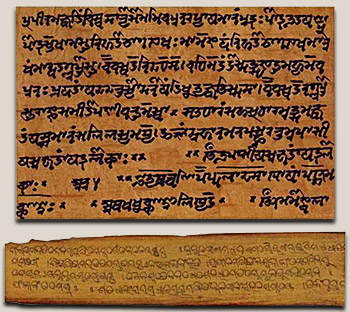
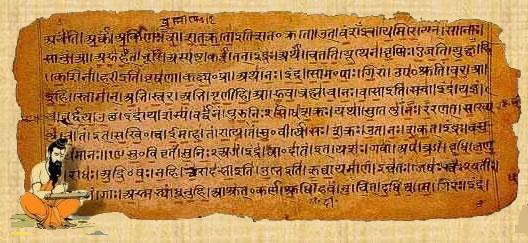
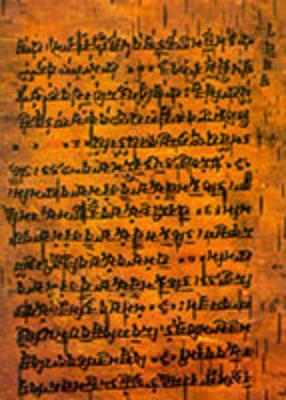
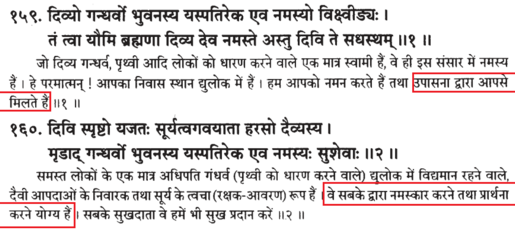
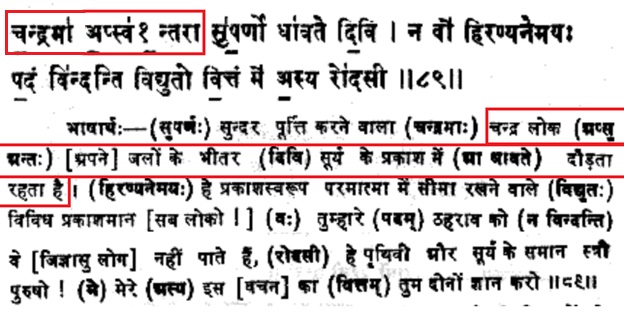
The Atharvavéda ( Sanskrit : अथर्ववेदः, Atharvavéda, a tatpurusha compound of atharvan, an ancient Rishi, and véda, meaning "knowledge" ) is a sacred text of Hinduism and one of the 4 Védas, often called the "fourth véda". According to tradition, the Atharvavéda was mainly composed by two groups of rishis known as the Atharvanas and the Angirasa, hence its oldest name is Ātharvāṅgirasa. In the Late Védic Gopatha Brāhmaṃā, it is attributed to the Bhrigu and Angirasa. Additionally, tradition ascribes parts to other rishis, such as Kauśika, Vasiṣṭha and Kaśyapa. There are two surviving recensions ( śākhās ), known as Śaunakīya ( AVS ) and Paippalāda ( AVP ).
The Atharvavéda Saṃhitā is the text 'belonging to the Atharvan and Angirasa poets. It has 760 hymns, and about 160 of the hymns are in common with the Rigvéda. Most of the verses are metrical, but some sections are in prose. It was compiled around 900 BCE, although some of its material may go back to the time of the Rigvéda, and some parts of the Atharvavéda are older than the Rigvéda though not in linguistic form.
The Atharvavéda is preserved in two recensions, the Paippalāda and Śaunaka. According to Apte it had 9 schools ( shakhas ). The Paippalada text, which exists in a Kashmir and an Orissa version, is longer than the Saunaka one; it is only partially printed in its two versions and remains largely untranslated.
Unlike the other 3 Védas, the Atharvavéda has less connection with sacrifice. Its first part consists chiefly of spells and incantations, concerned with protection against demons and disaster, spells for the healing of diseases, for long life and for various desires or aims in life.
The second part of the text contains speculative and philosophical hymns.
The Atharvavéda is a comparatively late extension of the "3 Védas" connected to priestly sacrifice to a canon of "4 Védas". This may be connected to an extension of the sacrificial rite from involving 3 types of priest to the inclusion of the Brāhmaṇ overseeing the ritual.
The Atharvavéda is concerned with the material world or world of man and in this respect differs from the other 3 Védas. Atharvavéda also sanctions the use of force, in particular circumstances and similarly this point is a departure from the 3 other Védas.
Status
The Atharvavéda, while undoubtedly belonging to the core Védic corpus, in some ways represents an independent parallel tradition to that of the Rigvéda and Yajurveda. It incorporates much of the early traditions of healing and magic that are paralleled in other Indo-European literatures.
The Atharvavéda is less predominant than other Védas, as it is little used in solemn ( Shrauta (Śrauta) ) ritual. The largely silent Brāhmaṇ priest observes the procedures of the ritual and "heals" it with two mantras and pouring of ghee when a mistake occurs. An early text, its status has been ambiguous due to its magical character.
Recensions
The Caraṇavyuha ( attributed to Shaunaka ) lists nine shakhas, or schools, of the Atharvavéda :
1. Paippalāda, regions south of the Narmada River
2. stauda
3. mauda
4. Śaunakīya, regions north of the Narmada River
5. jājala
6. jalada
7. kuntap
8. Brāhmavada
9. devadarŚa
10. cāraṇavaidyā
Of these, only the Śaunakīya ( AVS ), present in Gujarat, and the Paippalāda ( AVP ) recension in coastal Orissa have survived. Both have some later additions, but the core Paippalāda text is considered earlier than most of the Śaunakīya. Often in corresponding hymns, the two recensions have different verse orders, or each has additional verses not in the other.
Saṃhitāvidhi, Śāntikalpa and Nakṣatrakalpa are some of the five kalpa texts adduced to the Śaunakīya tradition and not separate schools of their own.
Two main post-Saṃhitā texts associated with the AV are the Vaitāna Sũtra and the Kauśika Sũtra. The VaitanaSũtra deals with the participation of the Atharvavéda priest ( Brāhmán ) in the Shrauta (Śrauta) ritual, while the KauśikaSũtra contains many applications of Atharvavéda mantras in healing and magic. This serves the same purpose as the vidhāna of the Rigvéda and is of great value in studying the application of the AV text in Védic times. Several Upanishad or Upaniṣads also are associated with the AV, but appear to be relatively late additions to the tradition. The most important of these are the muṇḍaka and the praŚna Upanishad or Upaniṣads. The former contains an important reference to Śaunaka, the founder of the Shaunakiya shakha, while the latter is associated with the Paippalāda shakha.
Dating
It is conjectured that the core text of the Atharvavéda falls within the classical Mantra period of Védic Sanskrit at the end of the 2nd millennium BCE - roughly contemporary with the Yajurveda mantras, the Rigvédic Khilani, and the Sāmavéda.
The Atharvavéda is also the first Indic text to mention iron ( as Śyāma ayas, literally "black metal" ), so that scholarly consensus dates the bulk of the Atharvavéda hymns to the early Indian Iron Age, corresponding to the 12th to 10th centuries BC, or the early Kuru kingdom.
Tradition suggests that Paippalāda, one of the early collators, and Vaidharbhī, one of the late contributors associated with the Atharvanic text, lived during the reign of prince Hiraṇyanabha of the Ikshvāku dynasty.
Divisions and issues of note
• The Shaunakiya text is clearly divided into four parts: Kāṇḍas 1-7 deal with healing and general black and white magic that is to be applied in all situations of life, from the first tooth of a baby to regaining kingship. Kāṇḍas 8-12 constitute early speculation on the nature of the universe and of humans as well as on ritual and are thus predecessors of the Upanishad or Upaniṣads. They continue the speculative tradition of some Rigvédic poets. Kāṇḍas 13-18 deal with issues of a householder's life, such as marriage, death and female rivalry, as well as with the ambiguous vrātyas on the fringes of society and with the Rohita sun as an embodiment of royal power. Kāṇḍa 19 is an addition, and Kāṇḍa 20 is a very late addition containing Rigvédic hymns for the use of the Atharvanic Brāhmaṃācchamsin priest as well as for the enigmatic Kuntapa ritual of the Kuru kingdom of Parikshit. The Paippalada text has a similar arrangement into four parts ( Kāṇḍas 1-15, 16-17, 18, 19-20 ) with roughly the same contents.
• The Paippalada text begins with shan no devir abhistaye, the most common Brāhmayajna mantra. The Shaunakiya text begins with ye trishapt, which is in the second Sūkta in the Paippalada Saṃhitā.
• The popular Gopala Tapini Upanishad or Upaniṣads, among Nimbarka Sampradaya and Gaudiya Vaishnavism, belongs to Paippalada Saṃhitā.
• Jain and Buddhist texts are considerably more hostile to the Atharvavéda ( they call it Aggvāna or Ahavāna véda ) than they are to the other Hindu texts.
• The AV is the first Indic text dealing with medicine. It identifies the causes of disease as living causative agents such as the yatudhāna, the kimīdin, the krimi or kṛmi and the durṇāma. The Atharvans seek to kill them with a variety of incantations or plant-based drugs in order to counter the disease ( see XIX.34.9 ). This approach to disease is quite different compared to the trihumoral theory of Ayurveda. Remnants of the original Atharvanic thought did persist, as can be seen in SuŚruta's medical treatise and in ( Garuḍa purāṇa, karma Kāṇḍa - chapter: 164 ). Here, following the Atharvan theory, the Purāṇic text suggests germs as a cause for leprosy. In the same chapter, SuŚruta also expands on the role of helminths in disease. These two can be directly traced back to the Atharvavéda Saṃhitā. The hymn AV I.23-24 describes the disease leprosy and recommends the rajani auṣadhi for its treatment. From the description of the auṣadhi as a black, branching entity with dusky patches, it is very likely that it is a lichen with antibiotic properties. Thus the AV may be one of the earliest texts to record uses of the antibiotic agents.
• The Atharvavéda also informs about warfare. A variety of devices, such as an arrow with a duct for poison (apāskambha) and castor bean poison, poisoned net and hook traps, use of disease-spreading insects and smoke screens find a place in the Atharvavéda Saṃhitā ( e.g., hymns IX.9 and IX.10, the trisaṃdi and nyārbudi hymns ). These references to military practices and associated kṣatriya rites were what gave the Atharvavéda its reputation. In the Mahābhārata, there is a frequent comparison between weapons and the mantras of the heroes.
• Several regular and special rituals of the Aryans ārya are a major concern of the Atharvavéda, just as in the three other Védas. The major rituals covered by the AV are marriage in Kāṇḍa - XIV and the funeral in Kāṇḍa - XVIII. There are also hymns that are specific to rituals of the bhṛgu-aṅgirasas, vrātyas and kṣatriyas. One peculiar rite is the Viṣāsahi Vrata, performed with the mantras of the XVII Kāṇḍa in a spell against female rivals. The Vrātya rituals were performed by individuals who took on a semi-nomadic way of living and were generally roaming about in neighboring tribal territories to gain wealth in cattle by putting pressure on householders grihastha. Finally, there are some rituals aimed at the destruction of the enemies ( Abhicārika hymns and rites ), particularly found in chapters 1-7. While these support traditional negative views on the AV, in content, they are mirrored by several other hymns from the Rig as well as the Yajuṣes. Moreover, Abhicārika rites were an integral part of Védic culture, as is amply attested in the Brāhmaṃā literature. Thus, the Atharvavéda is fully within the classic Védic fold, though it was more specific to certain Brāhmán clans of priests. The development of the Abhichārika rites to their more "modern" form is clearly seen in the vidhāna literature. The author of the ṛgvidhāna provides passing reference to the development of similar rites in the AV tradition ( the references to the Āṅgirasa Krityās ). These rites reached their culmination in the Kauśika Sũtra and in some of the Pariśiṣṭas ( appendices ) of the Atharvan literature.
• Philosophical excursions are found in books 8-12. One of the most spectacular expressions of philosophical thought is seen in the hymn XII.I, the Hymn to goddess Earth or the Pṛthivī Sūkta used in the āgrayana rite. The foundations of Vaiṣeśika Darśana is expressed in the mantra XII.1.26 in which the atoms ( Pāṃsu ) are described forming the stone, the stones agglutinating to form the rocks and the rocks held together to form the earth. Early pantheistic thought is seen in the hymn X.7 that describes the common thread running through all manifest and non-manifest existence as the skaṃbha. This skaṃbha is described as what poured out of the Hiraṇyagarbha that was the precursor of the complex world in a very simple form ( X.7.28 ). ( Hiraṇyagarba ="The golden womb from which the Universe was formed." ) This Skambha is Indra, and Indra is the Skambha which describes all existence. The hymn also describes a pantheistic nature of the Védic gods ( X.7.38 ): skaṃbha is the heat ( tapaḥ ) that spreads through the universe ( Bhuvana ) as waves of water; the units of this spreading entity are the gods even as branches of one tree. This theme is repeatedly presented in various interpretations in later Hindu philosophies.
Editions
The Shaunakiya text was edited by Rudolf Roth and William Dwight Whitney ( Berlin, 1856 ), Shankar Pandurang Pandit in the 1890s ( Bombay ) and by Vishva Bandhu ( Hoshiarpur, 1960–62 ). Translations into English were made by Ralph Griffith ( 2 vols., Benares 1897 ), D. Whitney ( revised by Lanman, 2 vols, Cambridge, Mass. 1905 ), and M. Bloomfield ( SBE Vol XLII ); also see Bloomfield, "The Atharvavéda" in "Grundriss der Indoarischen Philologie", II ( Strasburg, 1899 ).
The bulk of the Paippalāda text was edited by Leroy Carr Barret from 1905 to 1940 ( book 6 by F. Edgerton, 1915 ) from a single Kashmirian Śāradā manuscript ( now in Tübingen ). This edition is outdated, since various other manuscripts were subsequently discovered in Orissa. Some manuscripts are in the Orissa State Museum, but many manuscripts are in private possession and are kept hidden by their owners. A few manuscripts were collected by Prof. Durgamohan BhattAchãrya of Bengal by deceiving their owners, as told by his son Dipak BhattAchãrya in 1968 (below), who describes the theft as valiant daredevilry :
... The knowledge of the villagers, in whose possession many important manuscripts remain, about their possession is often very hazy [...] Prof. BhattAchãrya secured a manuscript from an illiterate Brāhmiṇ on promise of return ...
Books 1–15 were edited by Durgamohan BhattAchãrya ( 1997 ). There is a provisional (unpublished) edition of book 20 by Dipak BhattAchãrya.
Book 2 was edited and translated by Thomas Zehnder ( 1999 ) and book 5 by Alexander Lubotsky ( 2002 ), and books 6-7 by Arlo Griffiths ( 2004 ).
Recitation style of the Atharvavéda
The current recitation style of this véda mostly resembles the Rigvédic one.
The Shaunaka Shakha of the Atharvavéda is recited in western Saurastra, at Benares, Gokarna and, after a recent introduction from Benares, also in South India ( Tirupati, Chidambaram, etc. ). The Gokarna version follows the northern style, which resembles the way the Mahārashtrians recite the Rigvéda Saṃhitā. In Varanasi, which derives its style from Gujarat, the way of recitation is little different. Similarly in South India, the Shaunaka Shaka is recited using the Rigvéda as a base, with minute variations in Kampa Svara.
The Paippalada Shakha of the Atharvavéda is recited in Orissa in Saṃhitā-patha, however not with typical Védic svara and in south Jharkhand districts by some migrants of Utkala Brāhmiṇs, while its Kashmir branch has been extinct for some centuries.
| Data Arrangement, Technical Arrangement & Graphics |
|---|
| • Guruji Murugan Chillayah - World Yoga Association |
| References ( Atharvavéda ) |
| • Modak (1993) p.15 |
| • Shaunakiya text was edited by Rudolf Roth and William Dwight Whitney (Berlin, 1856) |
| • Shaunakiya text was edited by Shankar Pandurang Pandit in the 1890s (Bombay) |
| • Shaunakiya text was edited by Vishva Bandhu (Hoshiarpur, 1960–62) |
| • Translations into English by Ralph Griffith (2 vols., Benares 1897) |
| • Translations into English by D. Whitney (revised by Lanman, 2 vols, Cambridge, Mass. 1905) |
| • Translations into English by M. Bloomfield (SBE Vol XLII) |
| • Bloomfield, "The Atharvavéda" in "Grundriss der Indoarischen Philologie", II (Strasburg, 1899) |
| • Paippalāda text edited by Leroy Carr Barret from 1905-1940 (book 6 by F. Edgerton, 1915) |
| • Books 1–15 edited by Durgamohan BhattAchãrya (1997) |
| • provisional (unpublished) edition of book 20 by Dipak BhattAchãrya |
| • Book 2 edited & translated by Thomas Zehnder (1999) |
| • Book 5 by Alexander Lubotsky (2002) |
| • Books 6-7 by Arlo Griffiths (2004) |

Notes
READ MORE
English pronunciation : véda / Vētā / Vētam / Vēdham āyvukaḷ / ñāṉam Vaḷarcci Peṟa / Rikvēdaṁ / Rik vētam / Yajūr vētam / Sāma vētam / Atarvaṉa vētam /
Sanskrit संस्कृतम् : वेद /
Tamil தமிழ் : வேதா / வேதம் ஆய்வுகள் / ஞானம் வளர்ச்சி பெற / ரிக் வேதம் / யஜூர் வேதம் / சாம வேதம் / அதர்வன வேதம்
Bahasa Melayu : Rigvéda / Yajurveda / Sāmavéda / Atharvavéda /
Malayalam : not_available /
Telugu : రుగ్వేదం ( Rugvēdaṁ ) / యజుర్వేదం ( Yajurvēdaṁ) / సామవేదం ( Sāmavēdaṁ ) / అధర్వ వేదం ( Adharva vēdaṁ ) /
Français : not_available
Introduction
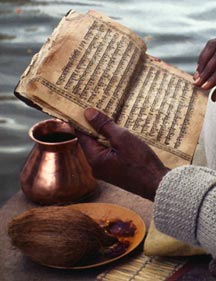
![]()
A vast number of statements and materials presented in the ancient Védic literatures can be shown to agree with modern scientific findings and they also reveal a highly developed scientific content in these literatures. The great cultural wealth of this knowledge is highly relevant in the modern world.
Techniques used to show this agreement include:


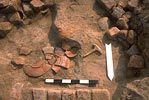
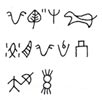

Introduction
Early indologists wished to control & convert the followers of Védic Culture, therefore they widely propagated that the Védas were simply mythology.

![]() Max Müller, perhaps the most well known early sanskritist and indologist, although later in life he glorified the Védas, initially wrote that the "Védas were worse than savage" and "India must be conquered again by education... it's religion is doomed"
Max Müller, perhaps the most well known early sanskritist and indologist, although later in life he glorified the Védas, initially wrote that the "Védas were worse than savage" and "India must be conquered again by education... it's religion is doomed"

![]() Thomas Macaulay, who introduced English education into India wanted to make the residents into a race that was: "Indian in blood and color, but English in taste, in opinion, in morals, and in intellect."
Thomas Macaulay, who introduced English education into India wanted to make the residents into a race that was: "Indian in blood and color, but English in taste, in opinion, in morals, and in intellect."

![]() However, the German Philosopher Arthur Schopenhauer stated that the Sanskrit understanding of these Indologists was like that of young
schoolboys.
However, the German Philosopher Arthur Schopenhauer stated that the Sanskrit understanding of these Indologists was like that of young
schoolboys.
Early Indologists
 These early Indologists:
These early Indologists:
Innumerable archaeological findings and their analysis have recently brought the Aryan Invasion Theory into serious question. This theory is still taught as fact in many educational systems despite much contrary evidence.

The Aryan Invasion Theory Defined
The Aryan Invasion Theory raises an interesting dilemna called Frawleys Paradox: On the one hand we have the vast Védic Literature without any archaeological finds associated with them and on the other hand, we have 2,500 archaeological sites from the Indus-SarāŚvata civilization without any literature associated with them.
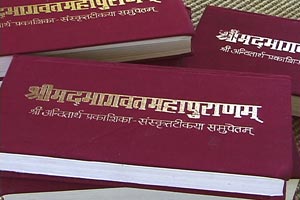
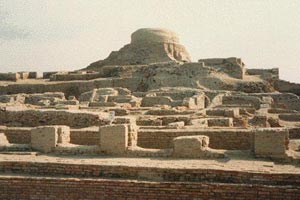
A preponderance of contemporary evidence now seems to indicate that these are one and the same cultures. This certainly eliminates this paradox and makes perfect sense, to an unbiased researcher.
Facts which cast serious doubt on the Aryan Invasion Theory
• There is no evidence of an Aryan homeland outside of India mentioned anywhere in the Védas. On the contrary, the Védas speak of the mighty SarāŚvati River and other places indigenous to India. To date, no evidence for a foreign intrusion has been found, neither archaeological, linguistic, cultural nor genetic.
• There are more than 2,500 Archaeological sites, two-thirds of which are along the recently discovered dried up SarāŚvati River bed. These sites show a cultural continuity with the Védic literature from the early Harrapan civilization up to the present day India.

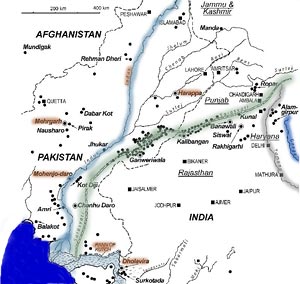
The archaeological sites along the dried up SarāŚvati River basin are represented by black dots.
• Several independent studies of the drying up of the SarāŚvati River bed, all indicate the same time period of 1,900 B.C.E.
• The significance of establishing this date for the drying up of the SarāŚvati River is, that it pushes the date for the composition of the Rigvéda back to approximately 3,000 B.C.E., as enunciated by the Védic tradition itself.
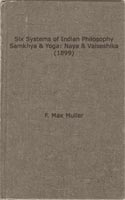 • The late dating of the Védic literatures by indologists is based on speculated dates of 1,500 B.C.E. for the Aryan Invasion and 1,200 B.C.E. for the Rigvéda, both now disproved by scientific evidence.
• The late dating of the Védic literatures by indologists is based on speculated dates of 1,500 B.C.E. for the Aryan Invasion and 1,200 B.C.E. for the Rigvéda, both now disproved by scientific evidence.

![]() Max Müller, the principal architect of the Aryan Invasion theory, admitted the purely speculative nature of his Védic chronology, and in his last work published shortly before his death, The Six Systems of Indian Philosophy, he wrote: "Whatever may be the date of the Védic hymns, whether 15 hundred or 15,000 B.C.E., they have their own unique place and stand by themselves in the literature of the world."
Max Müller, the principal architect of the Aryan Invasion theory, admitted the purely speculative nature of his Védic chronology, and in his last work published shortly before his death, The Six Systems of Indian Philosophy, he wrote: "Whatever may be the date of the Védic hymns, whether 15 hundred or 15,000 B.C.E., they have their own unique place and stand by themselves in the literature of the world."
The Védic Culture is indigenous to India
It can be scientifically proven that the Védic Culture is indigenous, through archaeology, the study of cultural continuity, by linguistic analysis, and genetic research.
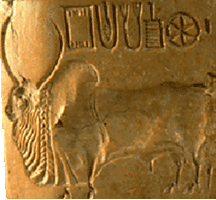
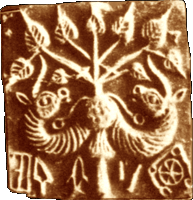
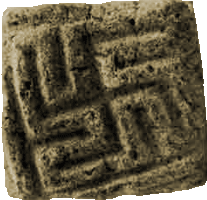
For example, the language and symbolism found on the Harappan seals are very Védic. We find the Om symbol, the leaf of the āŚvatta or holy banyan tree, as well as the swĀstika, or sign of auspiciousness, mentioned throughout the Védas. Om is mentioned in the Mundaka and Katha Upaniṣads as well as the Bhagavad Gita.
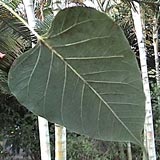
![]() The Holy āŚvatta tree is mentioned in the Aitareya and SatapataBrāhmaṇās as well as the Taittiriya Saṃhitā and KātyāyanaSmrti.
The Holy āŚvatta tree is mentioned in the Aitareya and SatapataBrāhmaṇās as well as the Taittiriya Saṃhitā and KātyāyanaSmrti.
The pictoral script of these Harappan seals has been deciphered as consistently Védic and termed "Proto-Brāhmi," as a pre-sanskrit script.
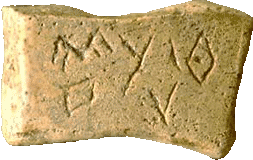 This piece of pottery from the
lowest level of Harappan excavations with pre-harappan writing is deciphered as ila vartate vara, referring to the sacred land bounded by the SarāŚvati River, described in the Rigvéda.
This piece of pottery from the
lowest level of Harappan excavations with pre-harappan writing is deciphered as ila vartate vara, referring to the sacred land bounded by the SarāŚvati River, described in the Rigvéda.
Additionally, other archaeological finds are culturally consistent, such as the dancing girl, whose bracelets are similar to those worn by women of Northwest India today as well as
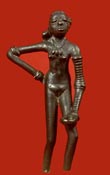
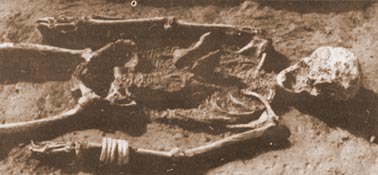
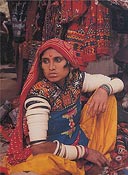
the three stone Siva Lingas found in Harappa by M. S. Vats in 1940. The worship of the Siva Linga is mentioned in the Mahā Narayana Upanisad of the Yajurveda and is still ardently practiced today.
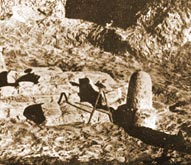

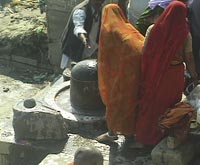
The Védas were maligned by early indologists because of their disagreement with their Eurocentric colonialists world view, a view which produced and depended on the Aryan Invasion Theory. The fact that the Aryan Invasion Theory has been seriously challenged recently by scholars and indologists, adds credence to the Védas as viable, accurate and indigenous sources of information.
Satellite imagery of the Dried Up SarāŚvati River Basin
Using modern scientific methods, such as satellite imagery and dating techniques, it can be shown that the ancient statements of the Védas are factual, not mythical as erroneously propagated. High resolution satellite images have verified descriptions in The Rigvéda of the descent of the ancient SarāŚvati River from it's source in the Himalayas to the Arabian Sea.



pra kṣodasā dhāyasā sasra
eṣā sarasvatī dharuṇamāyasī pūḥ
prabābadhānā rathyeva yāti
viŚvā apo mahinā sindhuranyāḥ
Rig Veda 07.095.01.1-2
"Pure in her course from the mountains to the ocean, alone of streams SarāŚvati hath listened."
The mighty SarāŚvati River and it's civilization are referred to in the Rigvéda more than fifty times, proving that the drying up of the SarāŚvati River was subsequent to the origin of the Rigvéda, pushing this date of origin back into antiquity, casting further doubt on the imaginary date for the so-called Aryan Invasion.
The Satellite image (above) clearly shows the Indus-SarāŚvata river system extending from the Himalayas to the Arabian Sea. Here the Indus River is on the left, outlined in blue, while the SarāŚvati River basin is outlined in green. The black dots are the many archeological sites or previous settlements along the banks of the now dry SarāŚvati River.
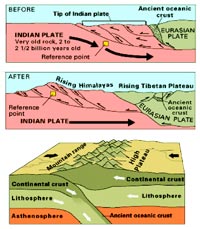
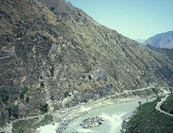 The drying up of the SarāŚvati River around 1900 B.C.E. is confirmed archaeologically. Following major tectonic movements or plate shifts in the Earth's crust, the primary cause of this drying up was due to the capture of the SarāŚvati River's main tributaries, the Sutlej River and the Drishadvati River by other rivers.
The drying up of the SarāŚvati River around 1900 B.C.E. is confirmed archaeologically. Following major tectonic movements or plate shifts in the Earth's crust, the primary cause of this drying up was due to the capture of the SarāŚvati River's main tributaries, the Sutlej River and the Drishadvati River by other rivers.
 Although early studies, based on limited archaeological evidence produced contradictory conclusions, recent independent studies, such as that of archaeologist James Shaffer in 1993, showed no evidence of a foreign invasion in the Indus SarāŚvata civilization and that a cultural continuity could be traced back for millennia.
Although early studies, based on limited archaeological evidence produced contradictory conclusions, recent independent studies, such as that of archaeologist James Shaffer in 1993, showed no evidence of a foreign invasion in the Indus SarāŚvata civilization and that a cultural continuity could be traced back for millennia.
In other words, Archaeology does not support the Aryan Invasion Theory.
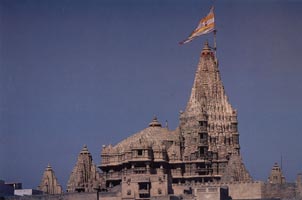 Evidence for the Ancient Port City of Dvaraka
Evidence for the Ancient Port City of Dvaraka
Marine archaeology has also been utilized in India off the coast of the ancient port city of Dvaraka in Gujarat, uncovering further evidence in support of statements in the Védic scriptures. An entire submerged city at Dvaraka, the ancient port city of Lord Krishna with its massive fort walls, piers, warfs and jetty has been found in the ocean as described in the Mahābhārata and other Védic literatures.
This sanskrit verse from the Mausala Parva of the Mahābhārata, describes the disappearance of the city of Dvaraka into the sea.
niryate tu jane tasmin
sāgaro makarālayaḥ
dvarakān ratna-sampūrṇan
jalenāplāvayattadā
( Mahābhārata, MP, 7, verse 40 )
"After all the people had set out, the ocean flooded Dvaraka, which still teemed with wealth of every kind. Whatever portion of land was passed over, the ocean immediately flooded over with its waters."
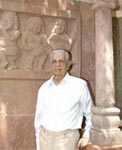 Dr. S. R. Rao, formerly of the Archaeological Survey of India, has pioneered marine archaeology in India. Marine archaeological findings seem to corroborate descriptions in the Mahābhārata of Dvaraka as a large, well-fortified and prosperous port city, which was built on land reclaimed from the sea, and later taken back by the sea. This lowering and raising of the sea level during these same time periods of the 15th and 16th centuries B.C.E. is also documented in historical records of the country of Bahrain.
Dr. S. R. Rao, formerly of the Archaeological Survey of India, has pioneered marine archaeology in India. Marine archaeological findings seem to corroborate descriptions in the Mahābhārata of Dvaraka as a large, well-fortified and prosperous port city, which was built on land reclaimed from the sea, and later taken back by the sea. This lowering and raising of the sea level during these same time periods of the 15th and 16th centuries B.C.E. is also documented in historical records of the country of Bahrain.
Amongst the extensive underwater discoveries were the massive Dvaraka city wall, a large door-socket and a bastion from the fort wall.



Two rock-cut slipways of varying width, extending from the beach to the intertidal zone, a natural harbor, as well as a number of olden stone ship anchors were discovered, attesting to Dvaraka being an ancient port city.


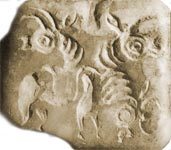
The three headed motif on this conch-shell seal (above), found in the Dvaraka excavations, corroborates the reference in the scripture Harivamsa that every citizen of Dvaraka should carry a mudra or seal of this type.
All these underwater excavations add further credibility to the validity of the historical statements found in the Védic literatures.
35 Archaeological Sites in North India
Apart from Dvaraka, more than thirty-five sites in North India have yielded archaeological evidence and have been identified as ancient cities described in the Mahābhārata. Copper utensils, iron, seals, gold & silver ornaments, terracotta discs and painted grey ware pottery have all been found in these sites. Scientific dating of these artifacts corresponds to the non-aryan-invasion model of Indian antiquity.

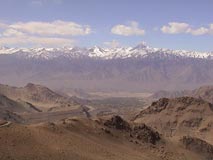
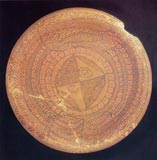
Furthermore, the Matsya and Vayu Puranas describe great flooding which destroyed the capital city of Hastinapur, forcing its inhabitants to relocate in Kausambi. The soil of Hastinapur reveals proof of this flooding. Archaeological evidence of the new capital of Kausambi has recently been found which has been dated to the time period just after this flood.
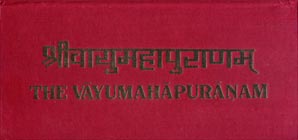


Kurukshetra
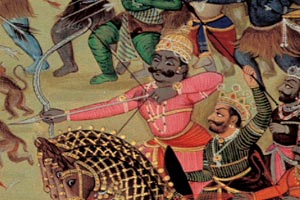
![]()
Similarly, in Kurukshetra, the scene of the great Mahābhārata war, Iron arrows and spearheads (according to some sources) have been excavated and dated by thermoluminence to 2,800 B.C.E., the approximate date of the war given within the Mahābhārata itself.
The Mahābhārata also describes three cities given to the Pandavas, the heroes of the Mahābhārata, after their exile:
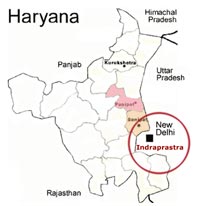 Paniprastha, Sonaprastha & Indraprastha, which is Delhi's Puranaqila. These sites have been identified and yielded pottery & antiquities, which show a cultural consistency & dating consistent for the Mahābhārata period, again verifying statements recorded in the Védic literatures.
Paniprastha, Sonaprastha & Indraprastha, which is Delhi's Puranaqila. These sites have been identified and yielded pottery & antiquities, which show a cultural consistency & dating consistent for the Mahābhārata period, again verifying statements recorded in the Védic literatures.
Renowned philosopher and writer: Renowned Thinkers Who Appreciated the Védic Literatures
Although early indologists, in their missionary zeal, widely vilified the Védas as primitive mythology, many of the worlds greatest thinkers admired the Védas as great repositories of advanced knowledge and high thinking

Arthur Schopenhauer, the famed German philosopher and writer, wrote that: I "...encounter [in the Védas] deep, original, lofty thoughts... suffused with a high and holy seriousness."
 The well-known early American writer Ralph Waldo Emerson, read the Védas daily. Emerson wrote:
"I owed a magnificent day to the Bhagavat-Gita"
The well-known early American writer Ralph Waldo Emerson, read the Védas daily. Emerson wrote:
"I owed a magnificent day to the Bhagavat-Gita"
 Henry David Thoreau said: "In the morning I bathe my intellect in the stupendous philosophy of the Bhagavad Gita... in comparison with which... our modern world and its literature seems puny and trivial."
Henry David Thoreau said: "In the morning I bathe my intellect in the stupendous philosophy of the Bhagavad Gita... in comparison with which... our modern world and its literature seems puny and trivial."
So great were Emerson and Thoreau's appreciation of védantic literatures that they became known as the American transcendentalists. Their writings contain many thoughts from Védic Philosophy.
 Other famous personalities who spoke of the greatness of the Védas were: Alfred North Whitehead (British mathematician, logician and philosopher), who stated that: "Védāṅta is the most impressive metaphysics the human mind has conceived."
Other famous personalities who spoke of the greatness of the Védas were: Alfred North Whitehead (British mathematician, logician and philosopher), who stated that: "Védāṅta is the most impressive metaphysics the human mind has conceived."
 Julius Robert Oppenheimer, the principle developer of the atomic bomb, stated that "The Védas are the greatest privilege of this century." During the explosion of the first atomic bomb, Oppenheimer quoted several Bhagavad-gita verses from the 11th chapter, such as:
Julius Robert Oppenheimer, the principle developer of the atomic bomb, stated that "The Védas are the greatest privilege of this century." During the explosion of the first atomic bomb, Oppenheimer quoted several Bhagavad-gita verses from the 11th chapter, such as:
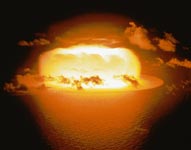 "Death I am, cause of destruction of the worlds..."
"Death I am, cause of destruction of the worlds..."
When Oppenheimer was asked if this is the first nuclear explosion, he significantly replied: "Yes, in modern times," implying that ancient nuclear explosions may have previously occurred.

Lin Yutang, Chinese scholar and author, wrote that: "India was China's teacher in trigonometry, quadratic equations, grammar, phonetics... " and so forth.

Francois Voltaire stated: "... everything has come down to us from the banks of the Ganges."
From these statements we see that many renowned intellectuals believed that the Védas provided the origin of scientific thought.
The Iron Pillar of Delhi

![]() The Védic literatures contain descriptions of advanced scientific techniques, sometimes even more sophisticated than those used in our modern technological world.
The Védic literatures contain descriptions of advanced scientific techniques, sometimes even more sophisticated than those used in our modern technological world.
Modern metallurgists have not been able to produce iron of comparable quality to the 22 foot high Iron Pillar of Delhi, which is the largest hand forged block of iron from antiquity.
 This pillar stands at mute testimony to the highly advanced scientific knowledge of metallurgy that was known in ancient India.
Cast in approximately the 3rd century B.C., the six and a half ton pillar, over two millennia has resisted all rust and even a direct hit by the artillary of the invading army of Nadir Shah during his sacking of Delhi in 1737.
This pillar stands at mute testimony to the highly advanced scientific knowledge of metallurgy that was known in ancient India.
Cast in approximately the 3rd century B.C., the six and a half ton pillar, over two millennia has resisted all rust and even a direct hit by the artillary of the invading army of Nadir Shah during his sacking of Delhi in 1737.
Védic Cosmology


Védic Cosmology is yet another ancient Védic science which can be confirmed by modern scientific findings and this is acknowledged by well known scientists and authors, such as Carl Sagan and Count Maurice Maeterlinck, who recognized that the cosmology of the Védas closely parallels modern scientific findings.
Carl Sagan stated, "Védic Cosmology is the only one in which the time scales correspond to those of modern scientific cosmology."
Nobel laureate Count Maurice Maeterlinck wrote of: "a Cosmogony which no European conception has ever surpassed."
 French astronomer Jean-Claude Bailly corroborated the antiquity and accuracy of the Védic astronomical measurements as "more ancient than those of the Greeks or Egyptians." And that, "the movements of the stars calculated 4,500 years ago, does not differ by a minute from the tables of today."
French astronomer Jean-Claude Bailly corroborated the antiquity and accuracy of the Védic astronomical measurements as "more ancient than those of the Greeks or Egyptians." And that, "the movements of the stars calculated 4,500 years ago, does not differ by a minute from the tables of today."

![]() The ninety foot tall astronomical instrument known as Samrat Yantra, built by the learned King Suwai Jai Singh of Jaipur, measures time to within two seconds per day.
The ninety foot tall astronomical instrument known as Samrat Yantra, built by the learned King Suwai Jai Singh of Jaipur, measures time to within two seconds per day.

Cosmology and other scientific accomplishments of ancient India spread to other countries along with mercantile and cultural exchanges. There are almost one hundred references in the Rigvéda alone to the ocean and maritime activity. This is confirmed by Indian historian R. C. Majumdar, who stated that the people of the Indus-SarāŚvata Civilization engaged in trade with Sooma and centers of culture in western Asia and Crete.
The Heliodorus Column and Cultural Links to India
An example of these exchanges is found in the inscriptions on the Heliodorus Column, erected in 113 B.C.E. by Heliodorus, a Greek ambassador to India, and convert to Vaisnavism, as well as the 2nd century B.C.E. Coins of Agathocles, showing images of Krishna and Balaram. These artifacts stand testimony that Sanatan Dharma predates Christianity


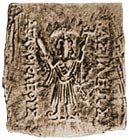
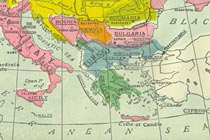
This also confirms the link between India and other ancient civilizations such as Greece and shows that there was a continuous exchange of culture, philosophy and scientific knowledge between India & other countries. Indeed the Greeks learned many wonderful things from India.
Védic Mathematics

 Voltaire, the famous French writer and philosopher) stated that "Pythagoras went to the Ganges to learn geometry." Abraham Seidenberg, author of the authoritative "History of Mathematics," credits the Sulba Sũtras as inspiring all mathematics of the ancient world from Babylonia to Egypt to Greece.
Voltaire, the famous French writer and philosopher) stated that "Pythagoras went to the Ganges to learn geometry." Abraham Seidenberg, author of the authoritative "History of Mathematics," credits the Sulba Sũtras as inspiring all mathematics of the ancient world from Babylonia to Egypt to Greece.
As Voltaire & Seidenberg have stated, many highly significant mathematical concepts have come from the Védic culture, such as:

The theorem bearing the name of the Greek mathematician Pythagorus is found in the Shatapatha Brāhmaṃā as well as the Sulba Sũtra, the Indian mathematical treatise, written centuries before Pythagorus was born.
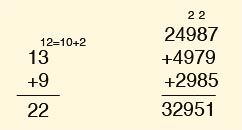
![]()
The Decimal system, based on powers of ten, where the remainder is carried over to the next column, first mentioned in the Taittiriya Saṃhitā of the Black Yajurveda.
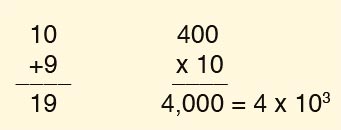
The Introduction of zero as both a numerical value and a place marker.

![]()
The Concept of infinity.
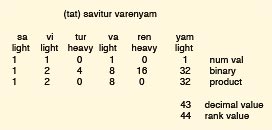
The Binary number system, essential for computers, was used in Védic verse meters.
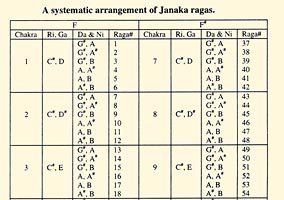
![]()
A hashing technique, similar to that used by modern search algorithms, such as Googles, was used in South Indian musicology. From the name of a raga one can
determine the notes of the raga from this Kathapayadi system. (See Figure at left.)
For further reading we refer you to this excellent article on Védic Mathematics.
Védic Sound and Mantras

![]() The Védas however are not as well known for presenting historical and scientific knowledge as they are for expounding subtle sciences, such as the power of mantras. We all recognize the power of sound itself by it's effects, which can be quite dramatic. Perhaps we all have seen a high-pitched frequency shatter an ordinary drinking glass. Such a demonstration shows that Loud Sounds can produce substantial reactions
The Védas however are not as well known for presenting historical and scientific knowledge as they are for expounding subtle sciences, such as the power of mantras. We all recognize the power of sound itself by it's effects, which can be quite dramatic. Perhaps we all have seen a high-pitched frequency shatter an ordinary drinking glass. Such a demonstration shows that Loud Sounds can produce substantial reactions
It is commonly believed that mantras can carry hidden power which can in turn produce certain effects. The ancient Védic literatures are full of descriptions of weapons being called by mantra. For example, many weapons were invoked by mantra during the epic Kuruksetra War, wherein the Bhagavad-gita itself was spoken.

![]() The ancient deployment of Brāhmastra weapons, equivalent to modern day nuclear weapons are described throughout the Védic literatures. Additionally, mantras carry hidden spiritual power, which can produce significant benefits when chanted properly. Indeed, the Védas themselves are sound vibrations in literary form and carry a profound message. Spiritual disciplines recommend meditational practices such as silent meditation, silent recitation of mantras and also the verbal repetition of specific mantras out loud.
The ancient deployment of Brāhmastra weapons, equivalent to modern day nuclear weapons are described throughout the Védic literatures. Additionally, mantras carry hidden spiritual power, which can produce significant benefits when chanted properly. Indeed, the Védas themselves are sound vibrations in literary form and carry a profound message. Spiritual disciplines recommend meditational practices such as silent meditation, silent recitation of mantras and also the verbal repetition of specific mantras out loud.

![]() A Clinical Test of the Benefits of Mantra Chanting was performed on three groups of sixty-two subjects, males and females of average age 25. They chanted the Hare Krsna Mahā Mantra twenty-five minutes each day under strict clinical supervision.
A Clinical Test of the Benefits of Mantra Chanting was performed on three groups of sixty-two subjects, males and females of average age 25. They chanted the Hare Krsna Mahā Mantra twenty-five minutes each day under strict clinical supervision.
Results showed that regular chanting of the Hare Krsna Mahā Mantra reduces Stress and depression and helps reduce bad habits & addictions. These results formed a PhD Thesis at Florida State University.
Spiritual practitioners claim many benefits from Mantra Meditation such as increased realization of spiritual wisdom, inner peace and a strong communion with God and the spiritual realm. These effects may be experienced by following the designated spiritual path.
Conclusion
Most of the evidence given in this presentation is for the apara Vidyā or material knowledge of the Védic literatures. The Védas however, are more renowned for their para Vidyā or spiritual knowledge. And even superior is the realized knowledge of the Védic rsis (rishis) or saints - that which is beyond the objective knowledge of modern science - knowledge of the eternal realm of sat, cit ananda, eternality, blissfullness and full knowledge. But that is another presentation.
BACK TO PAGE

Notes
READ MORE
Yoga Philosophy explores the fundamental teachings and principles that form the foundation of yogic practice. Rooted in ancient Indian texts, such as the Yoga Sutras of Patanjali and the Bhagavad Gita, yoga philosophy delves into concepts like mind control, self-realization, ethics, and the pursuit of spiritual liberation. It provides guidance on how to live a balanced, meaningful life through the integration of the eight limbs of yoga (Ashtanga Yoga), ethical guidelines (Yamas and Niyamas), and mental discipline. A deep understanding of yoga philosophy enriches the practitioner’s journey by cultivating wisdom, mindfulness, and self-awareness.
Scripture Studies in yoga focus on the study and interpretation of key ancient texts that provide profound insights into the practice and philosophy of yoga. Important scriptures like the Upanishads, Yoga Sutras, Bhagavad Gita, and Hatha Yoga Pradipika offer detailed teachings on the nature of the self, consciousness, meditation, and the path to spiritual liberation. By studying these sacred texts, practitioners gain a deeper understanding of yogic principles, enhancing their practice and enriching their spiritual journey. Scripture studies guide practitioners in applying timeless wisdom to modern life and deepen their connection to the essence of yoga.
BACK TO PAGE